Smartphones & Societal Issues: Uncovering Links
Did you know that the average person spends over 3 hours on their smartphone every day? That’s more than 1,000 hours a year! The impact of smartphones on society cannot be overstated, as they have become an integral part of our daily lives, affecting everything from our communication to our mental health. In this article, we will delve into the complex relationship between smartphones and societal issues, exploring the negative consequences of excessive smartphone use and its wide-ranging implications. Join us as we uncover the links between smartphones and the challenges they pose to our well-being and society as a whole.
Introduction to the Pervasiveness of Smartphones in Modern Society
In today’s rapidly evolving digital landscape, smartphones have become an integral part of our daily lives. From communication and entertainment to productivity and convenience, these devices have revolutionized the way we interact with the world around us. In this section, we will delve into the rise of smartphone usage across demographics, the transformation of smartphones from luxury items to ubiquitous necessities, and the core functions that have made them indispensable in shaping societal norms and behaviors.
The Psychological Impacts of Smartphones on Communication

In today’s digital age, smartphones have become an integral part of our lives, transforming the way we communicate with one another. However, their widespread use has also given rise to various psychological impacts on our interpersonal interactions and communication skills.
Alterations in Interpersonal Interactions and Conversational Depth
Smartphones have significantly altered the landscape of interpersonal interactions. With the constant presence of smartphones, face-to-face conversations have taken a backseat, as people are more engrossed in their digital devices. This shift in communication dynamics has led to a decline in conversational depth and genuine engagement with others.
Instead of deep, meaningful conversations and connections, interactions have become fragmented and superficial. The constant distractions and interruptions from smartphone notifications hinder our ability to fully engage in conversations and understand subtle nonverbal cues. As a result, the quality of communication has suffered, impacting our ability to form and maintain meaningful relationships.
Smartphones and the Decline of Face-to-Face Communication Skills
The overreliance on smartphones has also led to a decline in face-to-face communication skills. As more interactions occur through screens and keyboards, the art of effective face-to-face communication is gradually eroding. Skills such as active listening, maintaining eye contact, and interpreting body language are becoming less practiced and valued.
Furthermore, the convenience of smartphone communication has resulted in decreased motivation to engage in face-to-face conversations. People may prefer the ease of sending a text message or instant message, rather than having a real-time conversation. This shift in communication preferences can hinder our ability to develop essential social skills and navigate complex social dynamics effectively.
| Psychological Impacts of Smartphones on Communication | |
|---|---|
| Alterations in Interpersonal Interactions | Decline in Face-to-Face Communication Skills |
| – Fragmented and superficial conversations | – Decreased motivation for face-to-face conversations |
| – Lack of genuine engagement and understanding | – Erosion of essential social skills |
| – Impact on relationship building |
How could smartphones be linked to societal problems
Smartphones have become an indispensable part of our daily lives, shaping how we communicate, work, and navigate the world. While these devices offer convenience and connectivity, they are not without their consequences. The widespread use of smartphones has raised concerns about their potential impact on society and the various societal problems that may arise as a result.
One of the primary consequences of excessive smartphone usage is the negative impact on mental health. Research suggests that excessive screen time and social media usage can contribute to feelings of anxiety, depression, and loneliness. The constant exposure to curated online content and the pressure to maintain a certain online image can exacerbate these issues, leading to detrimental effects on individual well-being.
Moreover, smartphones have been linked to a decline in face-to-face communication skills, which are essential for building meaningful relationships and fostering social cohesion. With the rise of smartphone dependency, individuals may prefer online interactions over in-person connections, resulting in a reduced ability to develop and maintain interpersonal relationships.
Another societal problem associated with smartphones is the impact on productivity and work-life balance. The constant availability and accessibility of smartphones can blur the boundaries between personal and professional life, leading to increased stress and burnout. Additionally, the distraction and time spent on smartphone activities can hinder productivity, affecting overall work performance.
Furthermore, smartphones have contributed to an increase in distracted driving incidents, posing a significant risk to road safety. The temptation to use smartphones while driving has resulted in accidents, injuries, and even fatalities. This highlights the need for increased awareness and responsible smartphone usage to ensure the safety of individuals on the road.
By understanding these consequences of smartphone usage on society, we can begin to address the challenges they pose. Initiatives promoting digital well-being, such as setting boundaries for smartphone use and fostering mindful usage, can help mitigate the negative effects. Additionally, raising awareness about the potential societal problems associated with excessive smartphone usage can encourage individuals to adopt healthier habits and find a balance between technology and human interaction.
Exploring Privacy Concerns and Data Security in the Smartphone Era

In this section, we will delve into the privacy concerns and data security issues associated with smartphones in the digital era. As our reliance on smartphones continues to grow, so do our concerns about the safety and privacy of our personal information.
Rising Threats to Personal Privacy on Mobile Platforms
Smartphones have become a treasure trove of personal data, from our contacts and messages to our browsing history and location information. Unfortunately, this wealth of data also makes smartphones an attractive target for cybercriminals and hackers.
The rise of mobile platforms has brought about an increase in privacy breaches, exposing users to various threats such as data breaches, identity theft, and unauthorized access to personal information. With more and more apps requesting permission to access our personal data, it is essential to be vigilant about protecting our privacy.
Data breaches have become all too common, with even major companies falling victim to cyberattacks. The consequences of these breaches can be severe, leading to financial loss, reputational damage, and emotional distress for the individuals affected.
How Smartphones Contribute to Data Vulnerability
Smartphones are designed to be convenient and connected, allowing us to access a wealth of information and services at our fingertips. However, this convenience comes at a cost in terms of data vulnerability.
Many smartphone apps collect and store vast amounts of personal data, including our contacts, location, browsing habits, and even biometric information. While this data can enhance the functionality and personalization of our smartphones, it also increases the risk of data breaches and unauthorized access.
In addition, the always-on nature of smartphones means that our devices are constantly transmitting and receiving data, creating opportunities for interception and data theft. Public Wi-Fi networks, which are commonly used with smartphones, can be particularly vulnerable to man-in-the-middle attacks and other security breaches.
To mitigate these risks, it is crucial to take steps to enhance data security on our smartphones. This includes regularly updating our devices with the latest security patches, using strong and unique passwords, and being cautious about the apps we install and the permissions we grant.
| Steps to Enhance Data Security on Smartphones | |
|---|---|
| 1. Regularly update your device software | Keep your smartphone’s operating system and applications up to date to ensure you have the latest security patches. |
| 2. Use strong and unique passwords | Use a combination of letters, numbers, and special characters for your device and app passwords. Avoid using common passwords or reusing passwords across multiple accounts. |
| 3. Be cautious about app permissions | Review the permissions requested by apps before granting access to your personal data. Only give permissions that are necessary for the app’s intended functionality. |
| 4. Install antivirus and security apps | Consider installing reputable antivirus and security apps on your smartphone to protect against malware, phishing attempts, and other security threats. |
| 5. Use secure Wi-Fi networks | Avoid connecting to public Wi-Fi networks when transmitting sensitive data. If you must connect to public Wi-Fi, use a virtual private network (VPN) to encrypt your connection. |
Social Media’s Influence on Youth and the Role of Smartphones
In today’s digital age, social media has significantly influenced the behavior of young individuals, with smartphones playing a crucial role in facilitating this influence. The addictive nature of social media platforms and excessive smartphone usage among teenagers has raised concerns regarding their psychological well-being and societal impact.
Link between Smartphone Addiction and Social Media Usage in Teens
Studies have shown a strong correlation between smartphone addiction and the excessive use of social media platforms among teenagers. The constant need to stay connected and receive validation through likes, comments, and shares can lead to addictive behaviors and increased smartphone dependency. The widespread availability of smartphones and the easy access to social media platforms have amplified this phenomenon, with detrimental consequences on the overall well-being of young individuals.
The Psychological Consequences of Constant Digital Connection
The constant digital connection enabled by smartphones and social media has profound psychological consequences on youth behavior. Excessive use of social media can contribute to feelings of anxiety, depression, and low self-esteem, as young individuals compare their lives to the carefully curated highlight reels of others. Additionally, the continuous exposure to cyberbullying and online harassment can further exacerbate these psychological issues, posing a significant threat to the mental health of young individuals.
To illustrate this complex relationship between social media, smartphone addiction, and youth behavior, consider the following statistics:
| Statistic | Percentage |
|---|---|
| Teens who use social media for more than five hours per day | 32% |
| Teens experiencing symptoms of depression due to social media use | 27% |
| Teens who have been cyberbullied | 20% |
These statistics highlight the significant impact of social media on youth behavior and the urgency to address the psychological consequences of constant digital connection.
The Ecological Footprint of Smartphone Production and Disposal

In today’s society, smartphones have become an indispensable part of our lives. However, the environmental impact of smartphone production and disposal is often overlooked. In this section, we will delve into the ecological footprint of smartphone manufacturing and explore sustainable alternatives that can mitigate environmental hazards.
Environmental Hazards of Smartphone Manufacturing Processes
Smartphone production involves complex manufacturing processes that contribute to environmental hazards. From the extraction of raw materials to the assembly of components, each stage of the manufacturing process has its own environmental impact. For instance, the mining of minerals such as cobalt and lithium, used in smartphone batteries, often leads to deforestation, soil degradation, and water pollution. Additionally, the energy-intensive production methods and the generation of electronic waste further exacerbate environmental concerns.
According to a study by Greenpeace, the production of one smartphone generates an estimated 85 kilograms of carbon dioxide emissions. This is equivalent to the emissions produced by driving a car for 200 kilometers.
Furthermore, the improper disposal of smartphones poses a significant threat to the environment. E-waste, which includes discarded electronic devices like smartphones, contains toxic substances such as lead, mercury, and cadmium. When these substances leach into soil and water, they can contaminate ecosystems and harm both human and animal health.
Exploring Sustainable Alternatives to Current Industry Practices
The smartphone industry is starting to recognize the importance of sustainable practices and is taking steps to mitigate its environmental impact. One example is the incorporation of recycled materials into smartphone manufacturing, reducing the reliance on newly extracted resources. In addition, eco-friendly packaging and energy-efficient production processes are being implemented to minimize waste and energy consumption.
Moreover, consumer awareness and demand for sustainably produced smartphones are driving companies to adopt more environmentally friendly practices. Brands such as Fairphone are pioneering sustainable smartphone manufacturing by focusing on ethical sourcing, repairability, and longevity. By designing smartphones that are easy to repair and upgrade, they aim to extend the lifespan of devices and reduce electronic waste.
Government regulations and industry standards also play a crucial role in promoting sustainable smartphone production and disposal. Policy initiatives, such as extended producer responsibility, can hold manufacturers accountable for the end-of-life management of their products. Additionally, recycling programs and facilities can incentivize consumers to properly dispose of their old smartphones, facilitating the recycling and recovery of valuable materials.
By embracing sustainable alternatives and promoting responsible consumption and disposal, we can reduce the ecological footprint of smartphone production and contribute to a more environmentally conscious future.
Smartphones as a Tool for Reinforcing Social Inequalities
In today’s digital age, smartphones have become an integral part of our daily lives, with their impact reaching far beyond personal communication and entertainment. While smartphones have the potential to bridge gaps and connect people across different socioeconomic backgrounds, they can also inadvertently reinforce social inequalities. In this section, we will explore how smartphones contribute to social disparities and the barriers they create in terms of access to technology, education, and opportunities.
Access to Technology as a Measure of Socioeconomic Status
Access to smartphones and other digital devices has become a defining factor in determining one’s socioeconomic status. In many societies, having a smartphone is not merely a luxury but a necessity, enabling individuals to stay connected, access information, and participate in the digital world. However, not everyone has equal access to technology, creating a digital divide that disproportionately affects those from marginalized communities or low-income backgrounds.
The cost of smartphones, along with the ongoing expenses of data plans and internet access, can pose significant financial barriers for individuals and families who are already struggling to meet their basic needs. As a result, access to vital resources and opportunities that are increasingly reliant on digital platforms, such as job applications, educational resources, and social connections, are limited for those who cannot afford smartphones or access to reliable internet services.
Smartphones and the Digital Divide in Education and Opportunity
The digital divide extends beyond access to smartphones; it also encompasses disparities in digital literacy and the quality of education and opportunities available to different groups. As educational institutions increasingly integrate technology into their curricula, students without access to smartphones or reliable internet may face limitations in their learning experiences. This further perpetuates existing educational inequalities, hindering the academic progress and future prospects of marginalized students.
Furthermore, smartphones have become a gateway to various economic opportunities and platforms, such as remote work, freelance gigs, and online marketplaces. However, individuals without access to smartphones are often excluded from these opportunities, further widening the gap between socioeconomic classes.
It is imperative that efforts are made to bridge the digital divide and ensure equal access to technology, education, and opportunities for all members of society. By doing so, we can create a more inclusive and equitable society where smartphones serve as tools for empowerment rather than reinforcing social inequalities.
Mitigating Smartphone Distractions and Promoting Mindful Usage

Smartphones have become an integral part of our daily lives, providing us with constant connectivity and access to information. However, this reliance on digital devices can lead to distractions and hinder our ability to be present and engaged in the moment. To counteract this overreliance and cultivate a greater sense of presence, it is important to adopt strategies for mindful smartphone usage.
Strategies for Counteracting Overreliance on Digital Devices
Here are some effective strategies to help you reduce smartphone distractions:
- Create device-free zones: Designate specific areas or times in your daily routine where smartphones are not permitted. This can include meal times, family gatherings, or bedtime.
- Set boundaries: Establish clear rules and limits for smartphone usage, such as turning off notifications during work or designated relaxation times. Stick to these boundaries to create a healthier relationship with your device.
- Practice digital detox: Take regular breaks from your smartphone by setting aside dedicated periods of time without any digital distractions. Use this time to engage in activities that promote mindfulness, such as reading, meditating, or spending time in nature.
- Use productivity apps: Utilize smartphone apps that can help manage your screen time and promote focus. These apps can limit access to certain apps or websites during specific hours, helping you stay productive and minimize distractions.
- Engage in offline activities: Find hobbies and activities that do not require smartphone usage. This could include exercising, pursuing creative outlets like painting or playing musical instruments, or spending quality time with loved ones.
Techniques for Cultivating Presence and Authentic Engagement
In addition to counteracting overreliance, it is important to cultivate presence and authentic engagement in our interactions with smartphones. Here are some techniques to help you achieve this:
- Practice mindful smartphone usage: Before reaching for your phone, pause and ask yourself if the action is necessary and aligned with your current intentions. This simple act of mindfulness can help you become more aware of your smartphone habits.
- Practice active listening: When engaging in conversations or interacting with others, put your phone aside and give them your full attention. Actively listen and show genuine interest in what they are saying, fostering deeper connections and meaningful conversations.
- Engage in single-tasking: Instead of multitasking and constantly switching between different apps or activities, focus on one task at a time. This allows you to fully immerse yourself in the present moment and give your undivided attention to the task at hand.
- Cultivate gratitude: Take a moment each day to reflect on the positive aspects of your life that do not involve smartphones. Express gratitude for meaningful relationships, nature, or moments of solitude that allow for reflection and self-discovery.
By implementing these strategies and techniques, you can develop a healthier and more mindful relationship with your smartphone. Remember, the goal is not to completely disconnect from technology, but rather to create a balanced approach that allows you to be present and engaged in the world around you.
Smartphones and Emotional Health: Understanding the Connection

In today’s digital age, smartphones have become an integral part of our lives, impacting various aspects of our well-being, including our emotional health. As we rely more on technology, it is essential to acknowledge and understand the connection between smartphones and our emotional equilibrium.
Identifying Symptoms of Technology-Induced Stress and Anxiety
The pervasive use of smartphones can contribute to technology-induced stress and anxiety. Excessive screen time, constant notifications, and the pressure to stay connected can overwhelm and impact our mental well-being. Symptoms of technology-induced stress and anxiety may include:
- Feelings of restlessness and irritability
- Inability to relax or disconnect from digital devices
- Trouble focusing or concentrating
- Sleep disturbances and insomnia
- Increased levels of tension and unease
Recognizing these symptoms is crucial in addressing the negative impact of smartphones on our emotional health.
The Quest for Emotional Equilibrium in the Digital Age
In our quest for emotional equilibrium, it is essential to navigate the digital landscape mindfully. Developing strategies to promote a healthier relationship with our smartphones can help us maintain emotional well-being in the digital age.
Some strategies to consider include:
- Setting boundaries for screen time and establishing designated technology-free zones.
- Practicing self-care activities that promote relaxation and stress relief, such as meditation, exercise, or spending time in nature.
- Engaging in face-to-face interactions and strengthening relationships beyond digital platforms.
- Limiting exposure to social media and cultivating a healthy online presence.
By prioritizing our emotional well-being and adopting mindful smartphone usage habits, we can strive for a healthier balance between technology and our emotions.
The Role of Smartphones in Globalization and Cultural Exchange

In today’s interconnected world, smartphones play a vital role in fostering international connectivity and cross-cultural understanding. With their ability to connect people across borders and provide instant access to information, smartphones have become powerful tools for driving globalization and promoting cultural exchange.
Smartphones have revolutionized the way we communicate and interact with others, breaking down barriers and creating opportunities for cultural exchange. Through social media platforms, messaging apps, and video calls, individuals from different parts of the world can connect in real-time and share their experiences, traditions, and perspectives. This constant exchange of ideas and cultural practices has the potential to enrich our understanding of diverse cultures, fostering empathy and appreciation for global diversity.
However, it’s important to recognize that the impact of smartphones on cultural exchange is a double-edged sword. While smartphones facilitate the exchange of ideas, they also pose risks of cultural homogenization. As people around the world adopt similar technological habits and consume similar content, there is a concern that cultural diversity could be diluted, resulting in a loss of traditional practices and values.
The challenge lies in finding a balance between embracing the global connectivity that smartphones offer and preserving cultural diversity. This requires us to actively seek out and celebrate diverse voices, cultures, and perspectives while using smartphones as a tool for fostering understanding and empathy.
Fostering International Connectivity and Cross-Cultural Understanding
The widespread availability of smartphones has made it easier than ever to connect with individuals from different countries and cultures. Through social media platforms, individuals can engage in discussions, follow global events, and share their stories and experiences. This constant flow of information and communication breaks down geographical barriers, fostering international connectivity and promoting cross-cultural understanding.
The Double-Edged Sword of Cultural Homogenization
While smartphones enable us to connect with diverse cultures, there is a risk of cultural homogenization. As people consume content that is easily accessible through smartphones, there is a tendency for cultural practices, traditions, and values to converge. This could lead to a loss of cultural diversity and an erosion of unique cultural identities. It is crucial to actively promote and preserve cultural diversity while leveraging smartphones for global connectivity.
Designing a Future Where Technology and Humanity Coexist

In today’s rapidly evolving technological landscape, it is crucial to envision a future where technology and humanity can coexist harmoniously. As smartphones continue to play an integral role in our daily lives, it is essential to set boundaries for healthy technology consumption and prepare future generations for ethical smartphone use. By doing so, we can ensure that technology remains a tool for progress and well-being rather than a source of societal issues.
Setting Boundaries for Healthy Technology Consumption
A key aspect of designing a future with technology is establishing boundaries to promote healthy technology consumption. As smartphones become increasingly integrated into our lives, it is vital to find a balance between utilizing their capabilities and avoiding excessive usage. Encouraging individuals to engage in regular digital detoxes, prioritize face-to-face interactions, and establish designated screen-free times can help cultivate a healthier relationship with technology.
Preparing Future Generations for Ethical Smartphone Use
As we look to the future, it is essential to equip future generations with the knowledge and skills necessary for ethical smartphone use. This includes educating young individuals about the potential risks associated with excessive smartphone use, such as mental health issues and privacy concerns. By fostering digital literacy, promoting responsible online behavior, and teaching critical thinking skills, we can empower individuals to navigate the digital world responsibly and ethically.
Shaping Policy and Community Norms around Smartphone Usage
As smartphones have become an integral part of our daily lives, it is crucial to shape policies and community norms around their usage. Governmental regulation plays a vital role in ensuring ethical practices in smartphone distribution. By implementing guidelines and standards, governments can protect consumers from potential risks associated with smartphone usage, such as privacy breaches and data vulnerabilities.
Governmental Regulation and the Ethics of Smartphone Distribution
Governmental bodies have a responsibility to regulate the smartphone industry and ensure that smartphones are distributed ethically. This includes aspects such as fair labor practices, responsible sourcing of materials, and environmentally sustainable manufacturing processes. By establishing stringent regulations, governments can encourage smartphone manufacturers to prioritize ethical practices throughout the supply chain, promoting social and environmental responsibility.
Community Initiatives to Curb Smartphone Dependency
Alongside governmental regulation, community initiatives play a crucial role in curbing smartphone dependency. Community organizations, schools, and parents can collaborate to raise awareness about healthy smartphone usage and promote responsible digital citizenship. These initiatives can include educational programs, workshops, and support groups that focus on developing mindful and balanced smartphone habits. By fostering a community-driven approach, we can address the challenges of smartphone dependency together, creating a more harmonious relationship between individuals and their devices.
Ultimately, shaping policies and community norms around smartphone usage is imperative for us to create a healthier and more balanced relationship with smartphones. With effective governmental regulation and community-driven initiatives, we can ensure the ethical distribution of smartphones and promote responsible usage practices. By working together, we can harness the benefits of smartphones while mitigating the potential negative impacts on individuals, communities, and society as a whole.
Source Links
Smartphones History Timeline – Key Milestones
Did you know that there are currently more than 3.8 billion smartphone users worldwide? That’s nearly half of the global population!
Smartphones have transformed the way we live, communicate, and work. To understand the evolution of these devices, let’s explore the key milestones in the history of smartphones. From the inception of mobile communication to the revolutionary advancements in cellular networks, the rise of touchscreen innovation, and the advent of 5G, this timeline takes us through the significant moments that shaped the smartphone industry.
Key Takeaways:
- The number of smartphone users worldwide has exceeded 3.8 billion.
- Smartphones have had a profound impact on various aspects of our lives.
- The history of smartphones is marked by significant milestones and innovations.
- From mobile communication to 5G networks, smartphones have continuously evolved.
- Exploring the timeline of smartphones can provide valuable insights into their development and future possibilities.
The Inception of Mobile Communication: Pre-Smartphone Era
Before smartphones became an integral part of our lives, mobile communication had its early beginnings. In this section, we’ll explore the pre-smartphone era and the origins of mobile phones. From the first working prototype in 1973 to the approval of the first mobile phone in 1983, we’ll delve into the early stages of mobile communication and the technological advancements that laid the foundation for the future of smartphones.
During the pre-smartphone era, mobile phones were bulky and primarily focused on voice communication. The first working prototype, known as the Motorola DynaTAC 8000X, was developed in 1973 by Martin Cooper and his team at Motorola. This prototype laid the groundwork for future advancements in cell phone technology.
In 1983, the first commercial mobile phone, the Motorola DynaTAC 8000X, was approved by the FCC (Federal Communications Commission). This milestone marked the beginning of widespread mobile phone usage, albeit limited to a select number of users.
While these early mobile phones lacked the advanced features and capabilities of modern smartphones, they played a crucial role in shaping the future of mobile communication. The pre-smartphone era set the stage for the development of more compact, feature-rich devices that we now rely on for various aspects of our daily lives.
Next, let’s explore the revolutionary beginnings of mobile phones with Motorola’s groundbreaking entry and the launch of the first mobile phone in the next section.
Revolutionary Beginnings: Motorola and the First Mobile Phone
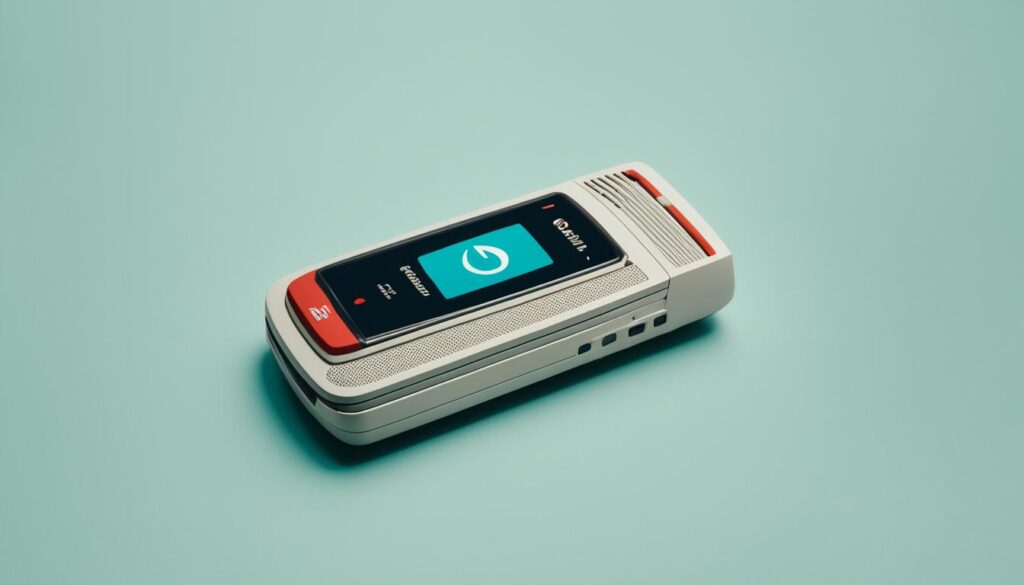
In the early development of mobile phones, Motorola played a pivotal role in shaping the industry. One of the key milestones in cell phone development was the launch of the first commercial mobile phone by Motorola in 1983. This groundbreaking device, known as the Motorola DynaTAC 8000X, marked the beginning of a new era in mobile communication.
The DynaTAC 8000X, affectionately referred to as the “brick” due to its size and weight, was an impressive feat of engineering for its time. It featured a sleek design with a long antenna and a large numeric keypad, allowing users to easily dial phone numbers. The phone’s display, although basic by modern standards, provided clear and legible characters.
Despite its hefty price tag of $3,995 (equivalent to over $10,000 in today’s currency), the DynaTAC 8000X was met with enthusiasm from consumers who were eager to embrace this cutting-edge technology. It offered a remarkable 30 minutes of talk time and a standby time of up to 8 hours, revolutionizing the way people communicated and stayed connected.
With the release of the DynaTAC 8000X, Motorola set the stage for further advancements in mobile phone technology. This device paved the way for smaller, more portable phones with enhanced features and capabilities. Motorola’s contribution to the development of the first mobile phone laid the foundation for the future of cell phones and set the industry on a trajectory of innovation and progress.
Motorola DynaTAC 8000X Specifications:
| Feature | Specification |
|---|---|
| Launch Year | 1983 |
| Dimensions | 13 x 1.75 x 3.5 in |
| Weight | 2.2 lbs |
| Battery Life | 30 minutes talk time, 8 hours standby |
| Network Compatibility | AMPS (Advanced Mobile Phone System) |
| Price | $3,995 |
From 1G to 2G: The Evolution of Cellular Networks
As mobile communication continued to advance, the evolution of cellular networks played a crucial role in enhancing the capabilities of smartphones. The transition from 1G to 2G marked a significant milestone in the historical progression of these networks.
The Launch of 1G and Ameritech’s Contribution
In the early 1980s, the first generation of cellular networks, commonly known as 1G, was introduced. Ameritech, one of the Regional Bell Operating Companies (RBOCs), played a vital role in the development and deployment of 1G technology. Their efforts led to the establishment of the first commercial cellular network in the United States in 1983. This network paved the way for mobile communication to become widely accessible and transformed the way people communicate on the go.
Transition to 2G: Advancements in Mobile Communications
The transition from 1G to 2G signaled a significant advancement in mobile communications. The introduction of 2G networks brought about several improvements, including better call quality, enhanced security features, and the ability to send text messages. This shift also paved the way for the integration of digital services and data transmission in mobile devices.
The advancements in 2G technology enabled more efficient use of the available radio frequencies, leading to increased capacity and improved network performance. This allowed users to experience faster and more reliable connections, enabling them to browse the internet, send emails, and access basic multimedia content on their smartphones.
Lithium-Ion Batteries: Powering the Next Generation of Cellular Devices
Another crucial development that accompanied the transition from 1G to 2G was the adoption of lithium-ion batteries in cellular devices. These advanced batteries provided higher energy density, longer lifespan, and better performance compared to their predecessors. Their introduction revolutionized the power capabilities of smartphones, allowing for extended usage and reduced downtime for charging.
The integration of lithium-ion batteries in mobile devices played a vital role in facilitating the growth and widespread adoption of smartphones. With longer battery life, users could rely on their devices for extended periods, making smartphones an indispensable tool in their daily lives.
| 1G | 2G |
|---|---|
| First generation of cellular networks | Second generation of cellular networks |
| Introduced in the early 1980s | Transitioned in the early 1990s |
| Analog technology | Digital technology |
| Provides basic voice calls | Enables data transmission and text messaging |
| Lower capacity and slower data transfer | Higher capacity and improved network performance |
The Dawn of Smartphones: IBM’s Groundbreaking Entry
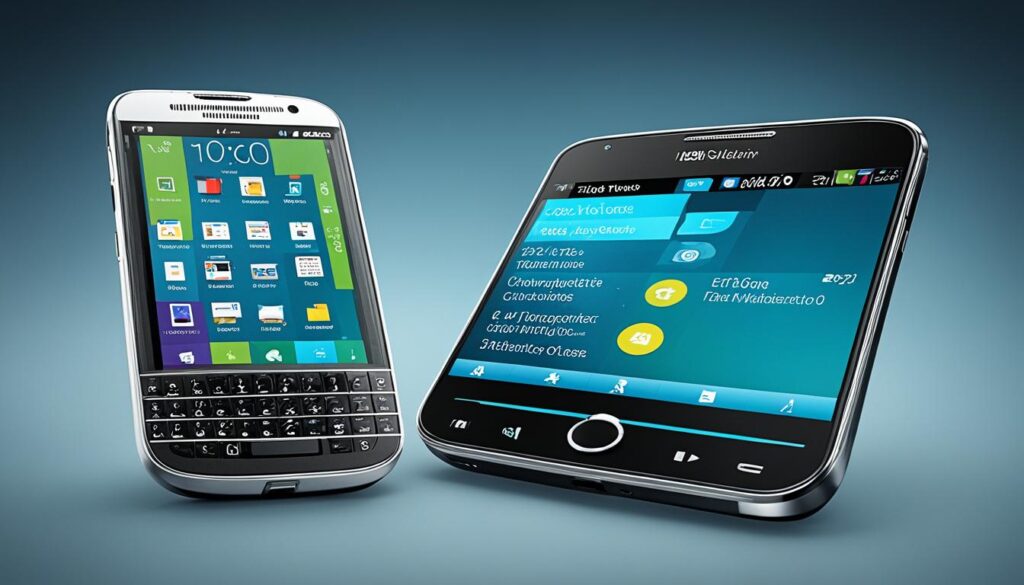
In this section, we’ll delve into the dawn of smartphones with IBM’s groundbreaking entry into the market. We’ll explore the prototype created by IBM engineer Frank Canova in 1992, which is considered the first true smartphone. We’ll discuss its features, its impact on the industry, and its eventual release to consumers.
Text Messaging and the Birth of Mobile Connectivity
Mobile connectivity took a significant leap with the introduction of text messaging. In 1992, the first text message was sent, forever changing the way we communicate using mobile devices. This innovation allowed people to send short, written messages to one another, creating a new form of instant communication.
Text messaging, also known as SMS (Short Message Service), quickly gained popularity and became an integral part of mobile phones. It enabled users to send and receive messages, making communication faster and more convenient. Whether it was sharing important information, planning meetups, or simply staying in touch, text messaging revolutionized mobile connectivity.
The ease and simplicity of text messaging made it a preferred mode of communication for people around the world. This new form of mobile connectivity transcended geographical borders and time zones, bringing people closer together.
With the birth of text messaging, mobile devices became more than just phones. They became personal communication tools that allowed individuals to stay connected, even when they were on the move.
Today, text messaging continues to play a vital role in our lives. From personal conversations to business communications, text messaging remains a reliable and efficient way to connect with others. It has evolved to include multimedia messages, group chats, and even business marketing campaigns.
As we reflect on the history of mobile phones, it is clear that text messaging was a pivotal moment in the development of mobile connectivity. Its impact can still be felt today, as we rely on text messaging to stay connected in our fast-paced, mobile-driven world.
Smartphones History Timeline: The Swift Progression Through the ’90s
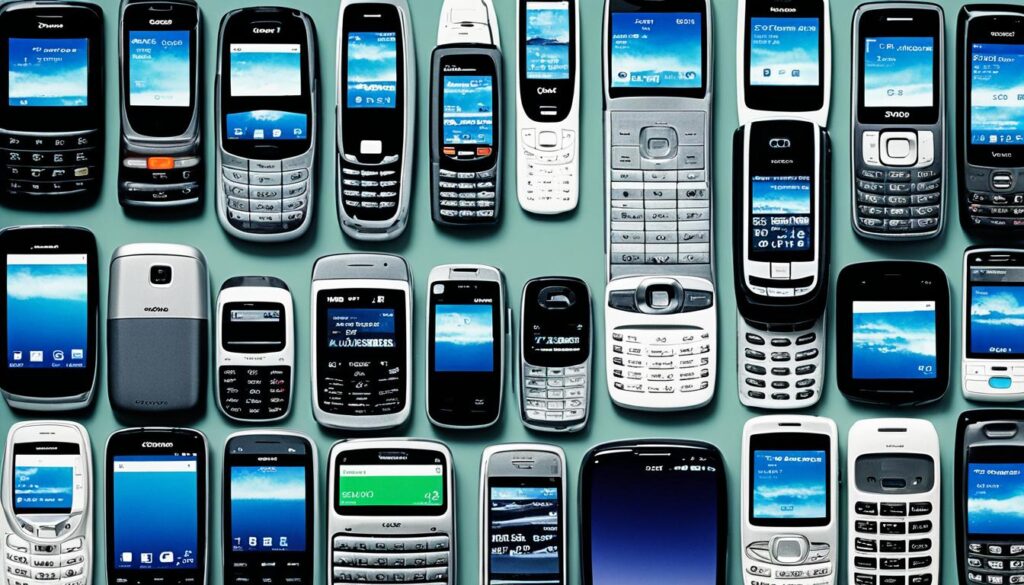
The 1990s marked a period of rapid development in the history of smartphones. In this section, we will explore two key aspects of this era that played a significant role in shaping the smartphone industry.
Ericsson’s Concept and the Coined Term “Smartphone”
During the ’90s, Ericsson paved the way for smartphone innovation with its groundbreaking concept. The company introduced the concept of a “smartphone,” a mobile device that combined the functionality of a cellular phone with advanced computing capabilities. This concept laid the foundation for the future of smartphones, leading to the convergence of communication and computing technologies.
“The introduction of the smartphone concept by Ericsson in the ’90s marked a turning point in the history of mobile devices. It sparked a new wave of innovation and set the stage for the smartphones we use today.”
Furthermore, Ericsson’s concept contributed to the popularization of the term “smartphone.” This coined term became widely recognized and used to refer to mobile phones with advanced features, capabilities, and connectivity beyond traditional cell phones.
The Advent of Mobile Gaming with Nokia’s Snake
In addition to Ericsson’s concept, the ’90s witnessed a significant milestone in the history of smartphones with the advent of mobile gaming. Nokia’s iconic game, Snake, captured the imagination of millions and revolutionized mobile entertainment.
“Nokia’s Snake game introduced a new era of mobile gaming, captivating users and demonstrating the potential of smartphones as entertainment devices. It set the stage for the vast array of gaming experiences that smartphones offer today.”
Snake, a simple yet addictive game, showcased the capabilities of smartphones beyond communication. Its popularity led to the development of more sophisticated mobile games and opened up new possibilities for entertainment on the go.
| Year | Key Milestones |
|---|---|
| 1990 | Introduction of Ericsson’s smartphone concept |
| 1992 | Debut of Nokia’s Snake game |
The Millennium’s Tech Boom: Camera Phones and 3G Introductions
The turn of the millennium brought significant advancements to smartphones. In this section, we’ll focus on the introduction of camera phones and the launch of 3G networks.
Camera phones revolutionized photography by allowing users to capture moments on the go. The first front-facing camera phone, the Kyocera VP-210, was released in 1999, enabling individuals to take self-portraits and engage in video calls. This innovation marked a new era in communication and self-expression.
With the commercial availability of camera phones, smartphones became more than just communication devices. People could now capture and share memories effortlessly, making photography a ubiquitous part of everyday life.
Simultaneously, the launch of 3G networks brought faster mobile internet speeds, transforming how we access information and communicate online. The 3G network allowed users to browse the internet, send emails, and stream media, expanding the possibilities of what a smartphone could offer.
Touchscreen Innovation and the Rise of iPhone’s Dominance
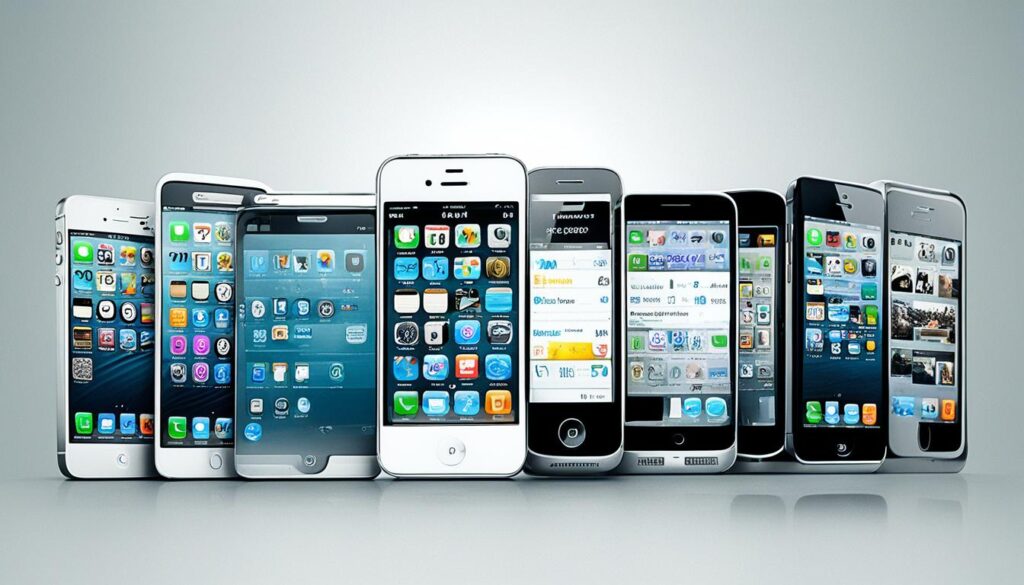
Touchscreen innovation revolutionized the smartphone industry. The introduction of touchscreens as the primary method of interaction with smartphones brought about a major shift in user experience and opened up new possibilities for functionality.
One of the key players in driving this innovation was Apple with its iconic iPhone. Launched in 2007, the iPhone quickly rose to dominance and set the standard for touchscreen smartphones. With its intuitive interface and multi-touch capabilities, the iPhone transformed the way people interacted with their devices, making it easier to navigate, browse the web, and perform various tasks.
The rise of the iPhone also spurred competition among other smartphone manufacturers, leading to further advancements in touchscreen technology. Companies such as Samsung, Google, and LG followed suit by integrating touchscreens into their devices, pushing the boundaries of what was possible with this innovative interface.
Today, touchscreen smartphones have become the norm, with nearly all smartphones featuring this technology. From simple taps and swipes to complex gestures and fingerprint recognition, touchscreens have become an integral part of our daily lives, enabling us to communicate, work, and entertain ourselves on the go.
The combined efforts of touchscreen innovation and the rise of the iPhone have not only revolutionized the smartphone industry but also paved the way for other touchscreen devices like tablets and smartwatches. As technology continues to evolve, we can expect further advancements in touchscreens, enhancing our interaction with these devices and driving new possibilities in the future.
Android Joins the Smartphone Arena: A New Era of Open-Source OS
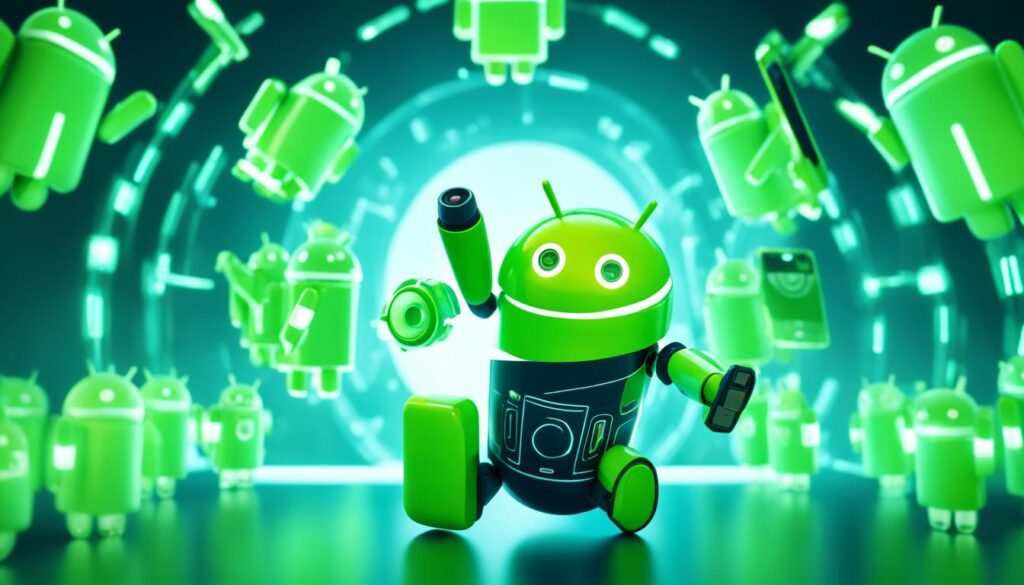
In the rapidly evolving world of smartphones, the entry of Android brought about a new era of open-source operating systems. With its debut in the early 2000s, Android quickly gained popularity and revolutionized the smartphone industry.
The Debut of the HTC Dream/T-Mobile G1
One of the key milestones in Android’s journey was the release of the HTC Dream, also known as the T-Mobile G1, in 2008. This groundbreaking device marked the first Android-powered mobile phone to hit the market. With its innovative features and user-friendly interface, the HTC Dream/T-Mobile G1 set the stage for the Android revolution.
The Significance of Google’s Android 1.0 Release
Accompanying the HTC Dream/T-Mobile G1 launch was the release of Google’s Android 1.0 operating system. This marked a significant milestone as it introduced an open-source OS to the smartphone market, enabling developers to create custom applications and making Android devices highly adaptable to user preferences. The release of Android 1.0 laid the foundation for the future of Android and its continuous growth in the smartphone industry.
| Key Points |
|---|
| The HTC Dream/T-Mobile G1 was the first Android-powered mobile phone. |
| Google’s Android 1.0 introduced an open-source OS to the smartphone market. |
| Android’s entry brought about a new era of highly customizable mobile devices. |
| The HTC Dream/T-Mobile G1 and Android 1.0 set the stage for Android’s rapid growth and popularity. |
4G Networks and the Surge of Mobile Internet Speeds

The introduction of 4G networks marked a significant leap in mobile internet speeds. With 4G, users experienced faster data transmission, enabling seamless streaming, rapid downloads, and enhanced browsing capabilities. This advancement revolutionized the way we connect and interact with the digital world on our smartphones and other mobile devices.
4G networks offered download speeds that were several times faster than their predecessors, providing a more efficient and enjoyable user experience. Tasks that were once time-consuming, such as downloading large files, streaming high-definition videos, and online gaming, became effortless and instantaneous.
The surge of mobile internet speeds brought numerous benefits to both individuals and businesses. Users could stay connected wherever they went, accessing information, communicating in real-time, and utilizing a wide range of mobile apps that depend on high-speed internet connectivity.
Businesses also capitalized on the opportunities presented by 4G networks. With faster mobile internet speeds, companies could enhance their online presence, develop innovative mobile applications, and provide seamless customer experiences. Industries such as e-commerce, media, transportation, and healthcare witnessed significant transformations, fueling economic growth and technological advancements.
Furthermore, the surge of mobile internet speeds paved the way for emerging technologies such as video streaming services, remote work and collaboration tools, and the Internet of Things (IoT). These developments revolutionized various aspects of our lives, from entertainment and communication to healthcare and transportation.
The impact of 4G networks on mobile connectivity cannot be overstated. As we continue to rely on smartphones and other mobile devices, it is crucial to acknowledge and appreciate the advancements brought about by 4G networks in shaping our digitally connected world.
The Advent of 5G and the Future of Connectivity

The advent of 5G networks promises to revolutionize connectivity. With its faster speeds, lower latency, and increased capacity, 5G has the potential to enable innovative technologies and transform various industries. This section will explore the introduction of 5G and its implications for the future of connectivity.
5G networks are expected to provide significantly faster download and upload speeds compared to previous generations. This means that tasks that currently take minutes, such as downloading large files or streaming high-quality videos, can be completed in a matter of seconds. The increased speed and lower latency of 5G will also enhance real-time applications such as video conferencing, online gaming, and virtual reality experiences.
Furthermore, 5G technology has the potential to support the massive growth of Internet of Things (IoT) devices. With its low latency and ability to connect a large number of devices simultaneously, 5G networks will enable seamless communication between devices, paving the way for more advanced smart homes, smart cities, and interconnected systems.
One of the most exciting prospects of 5G is its impact on autonomous vehicles. The high-speed, low-latency connectivity provided by 5G networks will enable real-time communication between vehicles, infrastructure, and pedestrians, creating safer and more efficient transportation systems. With reduced latency, autonomous vehicles will be able to make split-second decisions based on real-time data, revolutionizing the way we travel.
5G also has the potential to revolutionize industries such as healthcare, manufacturing, and entertainment. In healthcare, the high-speed connectivity of 5G will enable remote surgeries, real-time patient monitoring, and enhanced telemedicine capabilities. In manufacturing, 5G networks will facilitate seamless communication between machines, leading to increased efficiency and productivity. And in the entertainment industry, 5G will enable immersive experiences such as augmented reality and virtual reality on a mass scale.
“The advent of 5G networks marks a new era of connectivity, where faster speeds and lower latency will unlock endless possibilities for innovation and technological advancement.”
In summary, the advent of 5G networks holds tremendous potential for the future of connectivity. With its faster speeds, lower latency, and ability to support a massive number of devices, 5G will enable groundbreaking technologies and transform various industries. As we embrace the era of 5G, we can look forward to a more connected, intelligent, and innovative future.
Text Message Marketing: Transforming Business Communications
The Rise of Personalized SMS Campaigns
Text message marketing has revolutionized the way businesses communicate with their customers. Through personalized SMS campaigns, businesses can deliver targeted and relevant messages directly to their audience’s smartphones. This level of personalization allows companies to engage customers on a one-to-one basis, enhancing the effectiveness of their marketing efforts.
With personalized SMS campaigns, businesses can segment their customer base and tailor messages based on demographics, purchasing history, or specific interests. By sending personalized offers, recommendations, or event updates, businesses can create a more meaningful connection with their customers, increasing response rates and driving conversions.
Embracing Two-way Communication for Business Growth
In addition to personalized SMS campaigns, businesses are now embracing two-way communication to foster better relationships with their customers. By providing a channel for customers to easily respond, ask questions, or provide feedback via text messages, businesses can create a more interactive and customer-centric experience.
Two-way communication allows businesses to address customer inquiries promptly, provide real-time support, and gather valuable insights that can inform their product development or marketing strategies. By engaging in meaningful conversations with their customers, businesses can build trust, loyalty, and ultimately drive business growth.
Source Links
Who Started Smartphones? The Pioneers Revealed.
Smartphones have become an indispensable part of our modern lives. From communication and productivity to entertainment and navigation, these powerful devices have revolutionized the way we live and interact with technology. But have you ever wondered who started smartphones? Who were the visionaries behind this groundbreaking invention? In this article, we will delve into the origins of smartphones and reveal the pioneers who played a significant role in their development.
Join us on a journey through history as we uncover the fascinating stories of the smartphone inventors, the companies that led the revolution, and the technological advancements that reshaped the mobile industry. Discover the origins of the term ‘smartphone’ and explore the impact of early operating systems. We’ll also delve into the transformative impact of Apple’s iPhone and Google’s Android, as well as the role of app stores in smartphone adoption.
As we unravel the history of smartphones, we’ll also examine their profound impact on society, exploring how these devices have transformed communication, productivity, and various aspects of our everyday lives. And finally, we’ll look to the future and explore the next wave of smartphone innovations that promise to redefine the way we interact with technology.
Key Takeaways
- The origins of smartphones can be traced back to visionary inventors who had a vision for a new category of devices.
- IBM Simon, Nokia, and Research In Motion (BlackBerry) were among the companies that played a major role in starting the smartphone revolution.
- Symbian OS, Windows Mobile, and Palm OS were some of the early operating systems that powered smartphones.
- Apple’s iPhone redefined the concept of a smartphone, popularizing touchscreens and introducing the iOS ecosystem.
- Google’s Android democratized smartphone technology by providing an open-source operating system.
- App stores, such as the Apple App Store and Google Play Store, played a pivotal role in smartphone adoption.
- Smartphones have had a profound impact on society, transforming communication, productivity, and various aspects of everyday life.
- The future of smartphones holds potential advancements in foldable screens, 5G connectivity, and the integration of artificial intelligence and machine learning.
The Dawn of the Smartphone Era
In the early days of the smartphone era, a new category of devices emerged, thanks to the visionary minds of individuals who saw the potential for revolutionary mobile technology. These pioneers paved the way for the development of smartphones as we know them today.
The First Visionaries
Among the early visionaries who recognized the transformative power of smartphones was Martin Cooper, an engineer at Motorola. Cooper made history in 1973 when he placed the first-ever call from a handheld mobile phone. His invention laid the foundation for the future of mobile communication, inspiring other innovators to push the boundaries of what a phone could do.
A New Category of Devices
Building on the work of pioneers like Cooper, companies such as IBM and Nokia stepped forward to turn the concept of smartphones into reality. IBM’s launch of the Simon Personal Communicator in 1994 marked a significant milestone in the smartphone journey. It was the first device to combine mobile phone capabilities with other functionalities like email, fax, and calendar. This breakthrough device set the stage for the rapid evolution of smartphone technology.
Nokia, too, played a pivotal role in shaping the early smartphone landscape. With the introduction of devices like the Nokia 9000 Communicator in 1996, the company established itself as a leader in the smartphone market. These early smartphones offered a wide range of features, including internet connectivity and productivity tools, further expanding the possibilities of mobile communication.
The efforts of these visionaries and their commitment to pushing the boundaries of mobile technology laid the foundation for the smartphone revolution that would fundamentally transform the way we communicate, work, and live.
Invention of the Term ‘Smartphone’
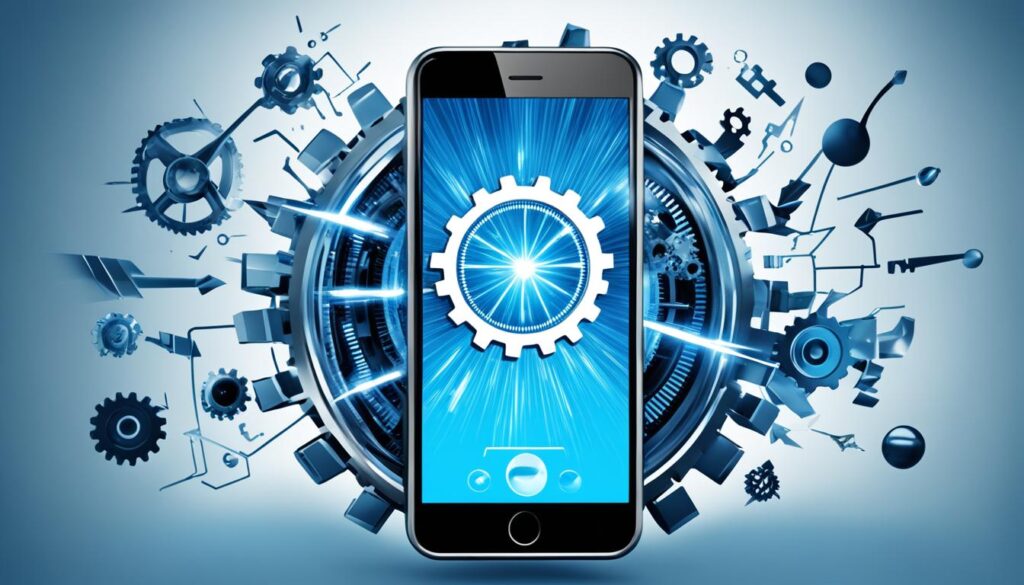
In the realm of mobile technology, the term ‘smartphone’ holds significant importance. But have you ever wondered where this term originated from? In this section, we will explore the origins of the term ‘smartphone’ and shed light on the individual who coined it.
When it comes to the invention of the smartphone term, there isn’t a singular individual credited with its creation. Rather, it emerged from the collective understanding of the evolving mobile phone industry and the amalgamation of various technological advancements.
During the early 2000s, as feature phones began incorporating more advanced capabilities such as email, web browsing, and productivity applications, the need to categorize these devices arose. The term ‘smartphone’ gained popularity as it encapsulated the idea of a phone that possessed enhanced capabilities beyond traditional voice communication.
“The smartphone is not just a phone but a pocket-sized computer capable of connecting to the internet and running various applications. It represents a paradigm shift in mobile communication and redefines our relationship with technology.” – Unknown
While there is no singular person who can be credited with coining the term ‘smartphone,’ it can be attributed to the collective efforts of multiple visionaries who contributed to the development and evolution of mobile technology. These visionaries envisioned a future where mobile phones would become more than just communication devices, propelling the industry forward.
| Year | Milestone |
|---|---|
| 1992 | Nokia introduces the first phone with a graphical user interface, the Nokia 1011. |
| 1993 | IBM unveils the Simon Personal Communicator, often considered the first smartphone due to its advanced features. |
| 1996 | Palm releases the PalmPilot, a handheld computer that popularizes personal digital assistants (PDAs) |
These early adopters contributed to the foundation of what we now know as smartphones. The term ‘smartphone’ became a common part of our vocabulary, representing a class of devices that have changed the way we communicate, work, and interact with the world around us.
With the invention of the smartphone term, a new era of mobile technology was born. The term served as a catalyst for the rapid evolution of these devices, setting the stage for the innovations and advancements that followed.
Who Started Smartphones: The Companies Behind the Revolution
In the early days of the smartphone revolution, several companies played pivotal roles in shaping the landscape of mobile communication. These companies drove innovation, introduced groundbreaking technologies, and ushered in a new era of smartphone devices.
IBM Simon: The First Smartphone?
One of the remarkable pioneers in the smartphone industry is IBM Simon. Released in 1994, the IBM Simon is widely considered the first true smartphone. It featured a touchscreen display, email capabilities, and even a built-in calendar. Although it was not as advanced as the smartphones we use today, the IBM Simon laid the foundation for future technological advancements.
The Rise of Nokia
Nokia, a Finnish company, also played a major role in the early years of the smartphone revolution. With its iconic models like the Nokia 9000 Communicator, Nokia brought innovation and functionality to the market. The Nokia 9000 Communicator, released in 1996, combined the features of a mobile phone and a personal digital assistant, setting the stage for the future of smartphones.
Research In Motion (BlackBerry) Leads the Market
An influential player in the smartphone revolution, Research In Motion (now known as BlackBerry) dominated the market for many years. The BlackBerry devices, with their physical keyboards and secure messaging capabilities, gained immense popularity among professionals and business users. They offered convenient email access and BBM (BlackBerry Messenger), revolutionizing the way people communicated on the go.
The contributions of these companies, including IBM Simon, Nokia, and Research In Motion (BlackBerry), laid the foundation for the smartphone revolution. They paved the way for the advancements we see in modern smartphones today, where companies continue to push boundaries and redefine the way we connect and interact with technology.
Operating Systems that Powered Early Smartphones

Early smartphones would not have been possible without the development of advanced operating systems that could handle the complex tasks required by these devices. In this section, we will explore three significant operating systems that played a crucial role in shaping the smartphone landscape: Symbian OS, Windows Mobile, and Palm OS.
Symbian OS: Opening the Doors
Symbian OS, developed by Symbian Ltd., was one of the first operating systems specifically designed for smartphones. It gained popularity in the early 2000s and became the dominant operating system for mobile devices worldwide. With its robust features and capabilities, Symbian OS enabled users to perform tasks such as web browsing, email management, and multimedia playback.
One of the notable features of Symbian OS was its support for third-party applications, which allowed developers to create and distribute software for smartphones. This opened the doors to a wide range of applications and enhanced the functionality of early smartphones.
Despite its initial success, Symbian OS faced increasing competition from other operating systems and eventually declined in popularity. However, its legacy can still be seen in the development of modern smartphone platforms.
Windows Mobile and Palm OS
Windows Mobile, developed by Microsoft, and Palm OS, developed by Palm, Inc., were two other significant operating systems that powered early smartphones.
Windows Mobile offered a familiar user interface, similar to that of Windows computers, which appealed to users already accustomed to Microsoft’s software ecosystem. It featured a wide range of applications and offered seamless integration with Microsoft Office and other productivity tools.
Palm OS, on the other hand, was known for its simplicity and ease of use. It provided a user-friendly interface and focused on intuitive navigation and organization of contacts, calendars, and other essential information. Palm OS devices, notably the Palm Pilot, gained popularity among professionals and became synonymous with personal digital assistants (PDAs).
Both Windows Mobile and Palm OS contributed to the early smartphone market, but with the rapid advancements in technology and the emergence of new players in the industry, their market shares declined over time.
Apple’s iPhone: Redefining the Smartphone
In this section, we will explore the revolutionary impact of Apple’s iPhone on the smartphone industry. The iPhone not only redefined the concept of a smartphone but also paved the way for a new era of mobile communication.
The Touchscreen Revolution
The introduction of the iPhone brought about a touchscreen revolution in the smartphone world. Unlike traditional phones with physical keyboards and buttons, the iPhone featured a large, capacitive touchscreen that revolutionized the way we interact with our devices. It allowed for intuitive gestures, such as swiping and pinching, making it easier and more seamless to navigate through apps, websites, and multimedia content.
iOS: A New Ecosystem Emerges
Alongside the groundbreaking hardware, Apple also introduced the iOS operating system, which further solidified the iPhone’s impact on the smartphone market. The iOS ecosystem offered a seamless user experience with a rich selection of apps, advanced security features, and regular software updates. It quickly became a benchmark for other smartphone platforms, setting new standards for performance, reliability, and user satisfaction.
Furthermore, Apple’s App Store provided a platform for developers to create and distribute innovative third-party apps, enhancing the functionality and versatility of the iPhone. This not only expanded the capabilities of the device but also opened up new avenues for businesses and individuals to connect, engage, and entertain through mobile applications.
| Apple’s iPhone Impact: | |
|---|---|
| Redefinition of the smartphone concept | – |
| Popularization of touchscreen technology | – |
| Introduction of the iOS operating system | – |
| Creation of a thriving app ecosystem | – |
| Setting new standards for performance and user experience | – |
Google’s Android: Democratizing Smartphone Technology

This section explores the impact of Google’s Android on the smartphone industry. It discusses how Android democratized smartphone technology by providing an open-source operating system and empowering a wide range of manufacturers to produce Android devices.
The rise of Google’s Android OS marked a significant milestone in the history of smartphones. With the introduction of Android, the smartphone market experienced a transformative shift towards openness and accessibility. Unlike proprietary operating systems, Android was open-source, providing developers with the freedom to customize and innovate.
This democratization of smartphone technology allowed a diverse array of manufacturers, from established industry players to emerging brands, to adopt Android as their operating system of choice. This resulted in an explosion of Android-powered devices, driving competition and choice in the market.
The impact of Android’s democratization can be seen in the increasing affordability and availability of smartphones. The wide range of Android devices caters to different price points and user needs, making smartphones accessible to a broader demographic.
Furthermore, Android’s open nature fostered a vibrant ecosystem of apps and services, thanks to the Google Play Store. Developers were able to create an extensive range of applications, providing users with a rich and diverse experience on their Android devices.
In addition, Android’s compatibility with a variety of hardware configurations ensured that manufacturers could innovate and experiment, pushing the boundaries of smartphone design and functionality.
Overall, Google’s Android OS played a pivotal role in democratizing smartphone technology, making it more accessible, affordable, and inclusive. Its open-source nature and widespread adoption have had a lasting impact on the smartphone industry, shaping the way we use and interact with our devices.
The Role of App Stores in Smartphone Adoption
In today’s mobile-driven world, app stores play a crucial role in the widespread adoption of smartphones. These digital marketplaces serve as convenient platforms for users to discover, download, and update applications tailored to their needs, enhancing the overall smartphone experience. Among the most influential app stores are the Apple App Store and the Google Play Store, each contributing to the rapid growth and evolution of the smartphone industry.
The App Store: Apple’s Game-Changer
The Apple App Store, launched in 2008, revolutionized the way users interacted with their iPhones. With its curated selection of innovative and diverse applications, the App Store transformed the iPhone into a versatile tool capable of catering to various interests and demands. The introduction of the App Store also paved the way for developers to showcase their creations, fostering a vibrant ecosystem of apps that continue to shape our digital lives. Today, the Apple App Store remains a cornerstone of smartphone app distribution, offering millions of apps to iPhone users worldwide.
Google Play Store Levels the Playing Field
Google’s response to the Apple App Store came in the form of the Google Play Store. Launched in 2012, the Play Store provided Android users with a vast selection of applications and games, expanding accessibility and choice beyond the iOS ecosystem. The Google Play Store enabled a multitude of smartphone manufacturers to embrace the Android operating system, fueling the proliferation of affordable, feature-rich devices. With its open and inclusive approach, the Play Store democratized app distribution, empowering developers worldwide to reach a broader audience.
| App Store | Launch Year | Key Features |
|---|---|---|
| Apple App Store | 2008 | Curated selection, innovation, vibrant ecosystem |
| Google Play Store | 2012 | Wide selection, affordability, openness |
Smartphones and Their Impact on Society

Smartphones have had a profound impact on society, revolutionizing the way we communicate, work, and live. The widespread adoption of smartphones has transformed the way people connect with each other, breaking down barriers of distance and enabling instant communication.
With smartphones, individuals can stay connected to friends, family, and colleagues through various communication apps, social media platforms, and messaging services. This constant connectivity has reshaped the way we maintain relationships, allowing for real-time interactions and quick exchanges of information.
Furthermore, smartphones have enhanced productivity by providing access to a wealth of information and tools right at our fingertips. Gone are the days of needing multiple devices for different tasks. Smartphones now serve as our portable offices, allowing us to check emails, manage calendars, access documents, and collaborate on projects no matter where we are.
Smartphones have also had a significant impact on various aspects of everyday life. They have transformed the way we consume media, with streaming services, e-books, and digital content becoming increasingly prevalent. The ability to capture high-quality photos and videos on smartphones has revolutionized the field of photography and allowed for instant sharing of memories.
Moreover, smartphones have become essential tools for navigation, providing real-time maps, directions, and transportation options. They have also become a gateway to accessing information, education, and entertainment, with apps and online platforms catering to a wide range of interests and needs.
The societal impact of smartphones cannot be underestimated. While they have undoubtedly brought numerous benefits and conveniences, they have also raised concerns about privacy, digital dependency, and attention span. It is crucial to strike a balance and approach smartphone usage mindfully, leveraging their capabilities while mitigating the potential drawbacks.
In conclusion, smartphones have revolutionized the way we communicate, work, and engage with the world around us. Their impact on society is far-reaching, touching various aspects of our lives. As technology continues to evolve, it will be fascinating to see how smartphones further shape our future and influence the way we connect and interact as a society.
Future Innovations and the Next Wave of Smartphones
As technology continues to advance at an unprecedented pace, the future of smartphones holds exciting possibilities. This section explores some of the innovations and advancements that we can expect to see in the next wave of smartphones. From foldable screens to 5G connectivity, and the integration of artificial intelligence (AI) and machine learning, these developments promise to redefine the smartphone experience.
Foldable Screens and 5G Connectivity
One of the most anticipated innovations in the future of smartphones is the emergence of foldable screens. This technology allows for a flexible display that can be folded or unfolded, providing users with a larger screen when needed and a compact form factor when on the go. Foldable screens offer new possibilities for multitasking, gaming, and media consumption, providing a more immersive and versatile user experience.
In addition to foldable screens, 5G connectivity is set to revolutionize the way we use smartphones. With significantly faster speeds and lower latency, 5G networks enable seamless streaming, rapid downloads, and real-time responsiveness. This technology will pave the way for more immersive augmented reality (AR) and virtual reality (VR) experiences, as well as advancements in cloud gaming and smart home integration.
Artificial Intelligence and Machine Learning Integration
Artificial intelligence (AI) and machine learning are poised to play a crucial role in the future of smartphones. As smartphones become more intelligent, they will be able to understand and anticipate our needs, providing personalized recommendations, automated tasks, and enhanced user interfaces. AI-powered voice assistants, such as Apple’s Siri and Google Assistant, will continue to evolve, offering more natural language processing and contextual understanding.
Machine learning algorithms will also contribute to improved camera capabilities, enabling smartphones to capture better photos, optimize settings based on scene recognition, and enhance image processing. Additionally, machine learning will drive advancements in battery optimization, app performance, and security, making smartphones more efficient and secure.
With foldable screens, 5G connectivity, and the integration of AI and machine learning, the future of smartphones holds immense potential. These innovations will not only transform the way we interact with our devices but also open up new possibilities for communication, entertainment, and productivity.
Debates on the True Inventor of the Smartphone

The true inventor of the smartphone has been the subject of intense debate and controversy in the tech industry. Various individuals and experts have put forth different perspectives and arguments, each claiming the title of the smartphone’s creator.
At the center of the smartphone inventor debate is a clash between multiple innovators who made significant contributions to the development of mobile technology. Some argue that the true inventor should be credited based on the first concept or prototype, while others focus on the commercial success and widespread adoption of a particular device.
“The creation of the smartphone was a collective effort that involved the dedication, innovation, and collaboration of many brilliant minds in the field of technology.” – Tech Expert
The controversy surrounding the true inventor of the smartphone stems from the fact that the concept of a mobile device with advanced computing capabilities and wireless connectivity was gradually developed and refined over time. It is difficult to attribute the creation of such a complex and multifaceted device to a single individual.
The ongoing smartphone creation controversy serves as a reminder of the rapid evolution and collaborative nature of technological advancements. While the debate continues, it is important to recognize and appreciate the contributions of all the pioneers who played a role in shaping the modern smartphone landscape.
Conclusion
In conclusion, the pioneers who started smartphones have left an indelible mark on the world of technology. We owe a debt of gratitude to visionaries such as IBM Simon, Nokia, and Research In Motion (BlackBerry) for their groundbreaking contributions. These companies played a crucial role in revolutionizing mobile communication and shaping the smartphone landscape as we know it today.
As we reflect on the origins of smartphones, it is clear that the evolution of smart device technology continues unabated. From the early days of touchscreen revolution brought by Apple’s iPhone to the democratization of smartphone technology by Google’s Android, we have witnessed remarkable advancements in recent years.
The impact of smartphones on society cannot be overstated. These devices have transformed the way we communicate, work, and navigate the world around us. With the rapid development of foldable screens, 5G connectivity, and the integration of artificial intelligence and machine learning, we can only imagine what the future holds for smart device technology.
Source Links
Exploring Different Types of Smartphones Today
Smartphones have become an integral part of our lives, serving as powerful tools of communication, entertainment, and productivity. With so many options available in the market, it can be overwhelming to choose the right smartphone that suits your needs. Are you curious about the different types of smartphones and the vast array of options? Let’s dive into the diverse world of smartphones and explore the various types and options available today.
From iOS to Android, Windows to Blackberry, and everything in between, smartphones come in various operating systems, each with its own unique features, designs, and user experience. Whether you’re a tech-savvy user, a business professional, or an elderly individual seeking a user-friendly device, there is a smartphone out there for every individual and their specific needs.
Key Takeaways:
- Smartphones offer a wide range of options and features, catering to different user preferences.
- Operating systems like iOS, Android, Windows, and Blackberry provide distinct experiences.
- Consider your specific needs and requirements when choosing a smartphone.
- There are options available for tech-savvy users, business professionals, and elderly individuals.
- Research and explore different smartphone options to make an informed decision.
iOS Smartphones
In this section, we will focus on iOS smartphones, specifically the iPhone series. We will explore the latest iPhone models, their features, and innovations, as well as the seamless integration with other Apple devices in the ecosystem. Whether you’re interested in the flagship iPhone models or more budget-friendly options, we will provide an in-depth analysis of the iOS smartphone ecosystem and its benefits.
Android Smartphones
Android smartphones are a dominant force in the smartphone market, offering a wide range of options from various manufacturers. One of the most popular Android smartphone series is the Samsung Galaxy, known for its powerful performance, stunning displays, and advanced camera capabilities. The Samsung Galaxy devices provide users with a seamless user experience, sleek designs, and an extensive range of features.
Another noteworthy player in the Android smartphone arena is the Google Pixel. Google Pixel smartphones are designed by Google itself, ensuring a smooth integration with the Android operating system. These devices are known for their exceptional camera quality, delivering stunning photos in various lighting conditions. Google Pixel smartphones also provide a clean and intuitive user interface, allowing for a user-friendly experience.
The Android operating system itself is highly regarded for its customization options, allowing users to personalize their devices to suit their preferences. From customizable home screens to the ability to use third-party launchers and widgets, Android offers a high level of flexibility. Additionally, the Google Play Store provides an extensive collection of apps, catering to a wide range of interests and needs.
“Android smartphones offer a diverse range of options, from high-end flagship devices to more budget-friendly models. With the Samsung Galaxy series and Google Pixel leading the way, Android users can enjoy top-notch performance, cutting-edge features, and an extensive app ecosystem.”
Whether you’re a tech enthusiast, a photography enthusiast, or simply looking for a reliable and customizable smartphone, Android devices provide a wealth of choices to suit your needs. With a vast selection of smartphones available, there is an Android phone for every individual, from power users to casual users.
Windows Smartphones
Windows smartphones, although less prevalent in the market, offer their own set of features and benefits. In this section, we will discuss Windows smartphones, their compatibility with the Windows operating system, and the unique capabilities they provide. While the availability of Windows smartphones may be limited compared to iOS and Android, there are still options for individuals who prefer the Windows ecosystem.
Windows smartphones are powered by the Windows operating system, developed by Microsoft, a renowned tech giant. These devices provide a seamless integration with other Windows devices, allowing users to enjoy a unified experience across their devices. With a Windows smartphone, users can easily access their Microsoft Office files, sync their calendars, and seamlessly transition between their smartphone and PC.
One of the unique capabilities of Windows smartphones is their ability to run full Windows applications, providing a desktop-like experience on a mobile device. This versatility is particularly appealing to business professionals and individuals who rely heavily on productivity tools. With a Windows smartphone, users can effortlessly switch between mobile apps and traditional desktop applications, enhancing their productivity on the go.
Furthermore, Windows smartphones offer a clean and intuitive user interface, known for its Live Tiles feature. Live Tiles provide real-time updates and notifications directly on the home screen, allowing users to stay informed without having to open individual apps. This feature enables quick access to important information and enhances overall user convenience.
“While Windows smartphones may not dominate the market, they offer a unique set of features and benefits that cater to a specific audience. Whether you are a business professional in need of seamless integration with other Windows devices or a productivity-focused individual looking for a versatile mobile device, Windows smartphones can certainly meet your needs.”
Despite their unique offerings, it’s important to note that the availability of Windows smartphones has become more limited in recent years, with Microsoft shifting its focus to other areas of the tech industry. However, for those who value the Windows ecosystem and its integration capabilities, there are still options available from various manufacturers.
In the next section, we will explore another once-popular smartphone brand that has a distinctive niche in the market – Blackberry smartphones.
Blackberry Smartphones

Blackberry smartphones have left a significant mark on the mobile industry, particularly due to their physical keyboards and robust security features. These devices have garnered a loyal following among business professionals and individuals who prefer the tactile experience of typing on a physical keyboard. One popular model that exemplifies Blackberry’s appeal is the Blackberry Torch.
The Blackberry Torch, known for its sleek design and functionality, combines the convenience of a touchscreen with a slide-out physical keyboard. This unique feature set caters to users who value both the convenience of a touch interface and the tactile feedback of physical keys. Throughout the years, Blackberry has continuously evolved its smartphones, incorporating advancements in software, security, and productivity features.
Despite facing challenges in the highly competitive smartphone market, Blackberry retains its identity as a brand synonymous with security and productivity. The ability to quickly and efficiently compose emails, write documents, and navigate through applications with a physical keyboard sets Blackberry smartphones apart from their touchscreen-dominated counterparts.
Whether for professionals who prioritize efficient communication or individuals who appreciate the familiarity of physical keyboards, Blackberry smartphones continue to offer a distinctive user experience.
Google is not only the developer of the popular Android operating system but also manufactures its own line of smartphones known as Google Pixel. These smartphones are designed to seamlessly integrate with the Android ecosystem and offer unique features and camera capabilities. For individuals who heavily rely on Google services and apps, Google smartphones provide a cohesive and optimized user experience.
The Google Pixel series is known for its exceptional camera quality, allowing users to capture stunning photos and videos. Whether it’s low-light photography, portrait mode, or advanced image processing, Google smartphones consistently deliver impressive results. The combination of hardware and software optimization ensures that every shot taken with a Google Pixel smartphone is of the highest quality.
Other Smartphone Options
In addition to the major smartphone players like iOS, Android, Windows, and Blackberry, there are several other smartphone options available in the market. These alternative smartphones cater to individuals who seek different features, designs, or price ranges. If you’re looking for something beyond the mainstream, exploring niche smartphone brands can be an exciting alternative.
These niche brands offer unique offerings that differentiate them from the more well-known players in the market. Whether you’re looking for a smartphone with a specific feature, a distinctive design, or simply want to support smaller, independent brands, these alternative options can provide a refreshing change.
While these brands may not have the same level of recognition or market share as the major players, they often offer competitive specifications and innovative features at a more affordable price point. This makes them an attractive choice for budget-conscious consumers who still want a quality smartphone.
Some niche smartphone brands worth exploring include OnePlus, Xiaomi, Oppo, and Vivo. These brands have gained popularity for delivering reliable performance, attractive designs, and unique features that appeal to certain segments of the market.
Furthermore, alternative smartphones from niche brands can provide a level of exclusivity and personalization that is not always available with mainstream options. These brands often have loyal fan bases and communities that value their distinct offerings and the sense of belonging they provide.
Ultimately, when considering smartphone options, it’s essential to evaluate your needs and preferences. If you’re looking for something different, exploring alternative smartphone brands can open up a world of possibilities, allowing you to find the perfect device that aligns with your unique requirements.
The Evolution of Smartphones: A Historical Perspective
In this section, we will take a historical perspective on the evolution of smartphones. From their humble beginnings to their status as indispensable devices in our daily lives, smartphones have come a long way. We will delve into the birth of the smartphone, explore key milestones in smartphone development, and examine how smartphones have transformed over time.
The Birth of the Smartphone
The story of the smartphone begins in the late 20th century when the concept of a handheld device capable of communication and computation started to take shape. The first true smartphone, the IBM Simon, was introduced in 1994. It featured a touchscreen, email capabilities, and even a rudimentary web browser. Although it lacked many of the features we now associate with smartphones, the IBM Simon laid the foundation for what was to come.
Key Milestones in Smartphone Development
Over the years, smartphones have undergone significant advancements and innovations. Here are some key milestones that shaped the smartphone landscape:
- The Introduction of Touchscreens: The year 2007 marked a major turning point with the release of the iPhone, which introduced the revolutionary concept of touchscreens. This intuitive interface became the new standard for smartphones.
- The Integration of Cameras: With the introduction of built-in cameras, smartphones became powerful tools for capturing and sharing images. The inclusion of higher resolution sensors and advanced camera technologies further enhanced the photography capabilities of smartphones.
- The Advancement of Processing Power: As processing power grew exponentially, smartphones became capable of performing complex tasks and running resource-intensive applications. This advancement opened up new possibilities for gaming, multimedia, and productivity.
How Smartphones Have Transformed Over Time
Smartphones have evolved from simple communication devices to multi-functional gadgets that provide endless possibilities. They have become integral parts of our lives, serving as our personal assistants, entertainment centers, and gateways to the digital world. From browsing the internet to managing our schedules, smartphones have transformed the way we work, communicate, and access information.
In conclusion, the evolution of smartphones has been an incredible journey. From the birth of the first smartphone to the key milestones in development, smartphones have continuously pushed the boundaries of technology. As we look to the future, it is exciting to imagine how smartphones will continue to evolve and shape our lives.
| Year | Milestone |
|---|---|
| 1994 | Introduction of the IBM Simon, the first true smartphone |
| 2007 | Release of the iPhone, introducing touchscreens |
| 2000s | Integration of cameras in smartphones |
| 2010s | Advancement of processing power in smartphones |
Mainstream Smartphone Operating Systems
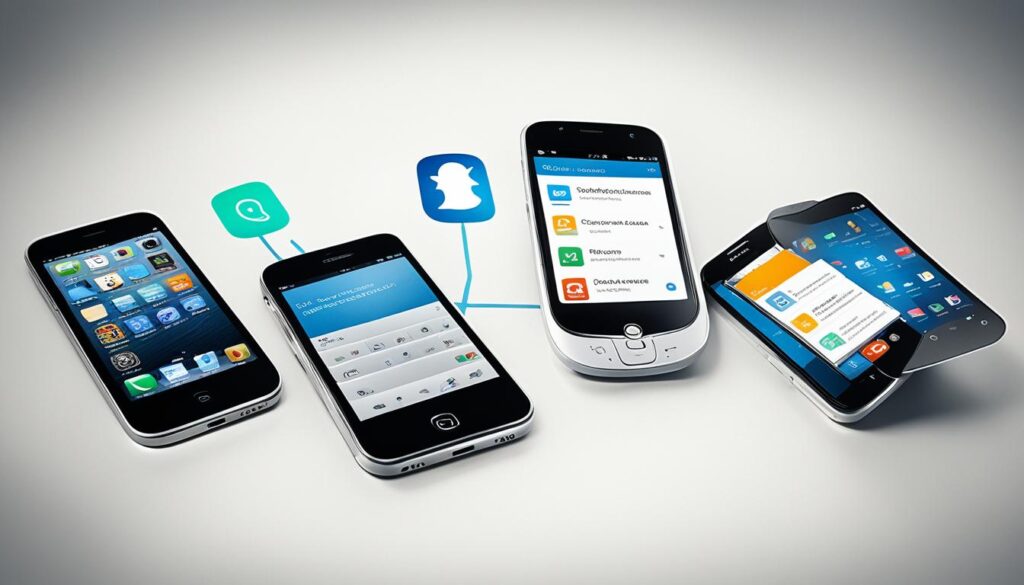
In this section, we will delve deeper into the mainstream smartphone operating systems, namely iOS, Android, and Windows. We will discuss the unique features, user experience, and app ecosystems of each operating system, providing insights into their strengths and weaknesses. By understanding the differences between these operating systems, readers can make informed decisions when choosing a smartphone.
When it comes to smartphone operating systems, three major players dominate the market: iOS, Android, and Windows. Each operating system offers a distinct user experience and caters to different needs and preferences. Let’s take a closer look at each of these operating systems:
iOS
iOS, developed by Apple, powers iPhones and is known for its intuitive interface and seamless integration with other Apple devices. The iOS ecosystem offers a curated selection of high-quality apps and a focus on privacy and security. Apple releases regular updates to improve performance and introduce new features. The latest version, iOS 15, introduced enhanced FaceTime capabilities, redesigned notifications, and improved multitasking.
Android
Android, developed by Google, is the most widely used smartphone operating system globally. It offers a customizable user interface and a vast array of apps from the Google Play Store. Android provides users with more flexibility in terms of device options across various price ranges, allowing for greater customization and personalization. The latest version, Android 12, introduced a new Material You design language, enhanced privacy features, and improved performance.
Windows
Windows, developed by Microsoft, offers a unique operating system for smartphones. While Windows smartphones are less prevalent in the market compared to iOS and Android devices, they provide a seamless integration with Windows PCs and other Microsoft services. Windows smartphones offer a familiar desktop-like interface and productivity features for users who heavily rely on Microsoft Office tools and services.
Each operating system has its own strengths and weaknesses, and the choice of a smartphone operating system ultimately depends on individual preferences and requirements. Whether you prioritize a seamless ecosystem, app availability, customization options, or integration with other devices, understanding the features and user experience offered by iOS, Android, and Windows will help you make an informed decision.
Understanding Smartphone Form Factors and Designs
Smartphones have evolved over the years, offering a wide range of form factors and designs to suit different user preferences. In this section, we will explore the various types of smartphone form factors and discuss the advantages and considerations of each design. Additionally, we will dive into the emerging trend of foldable phones and their potential impact on smartphone design.
One of the most common smartphone form factors is the candy bar design, which features a rectangular shape with a touchscreen display occupying the front of the device. This design maximizes screen real estate and provides a comfortable grip for users.
Another popular form factor is the slider design, which incorporates a sliding mechanism to reveal a physical keyboard or additional display. This design offers a combination of touchscreen and physical input options, catering to users who prefer a tactile typing experience.
Similarly, flip phones have seen a resurgence in popularity, especially among those who prioritize compactness and nostalgia. These phones feature a folding mechanism that allows the device to be folded in half, protecting the display and creating a smaller form factor when closed.
One of the most exciting developments in smartphone design is the emergence of foldable phones. These devices feature flexible displays that can be folded or unfolded, allowing for a larger screen experience without sacrificing portability. Foldable phones offer the convenience of a tablet-sized display that can be folded into a more pocket-friendly form.
To visually demonstrate the different smartphone form factors, take a look at the image below:
“Smartphones have come a long way in terms of design, offering various form factors to cater to individual preferences. From candy bar designs, sliders, and flip phones to the innovative concept of foldable phones, there is a smartphone design for everyone. Each design has its own advantages and considerations, allowing users to choose a device that suits their needs and style.”
As smartphones continue to evolve, it’s exciting to see how manufacturers will push the boundaries of design to offer even more unique and innovative form factors in the future.
High-End Smartphones: Features and Innovations
High-end smartphones are designed to offer the latest advancements and cutting-edge features, catering to tech enthusiasts and power users. These flagship phones from top brands push the boundaries of smartphone technology, providing users with a premium experience.
Premium Materials and Build Quality
One of the hallmarks of high-end smartphones is their premium materials and exceptional build quality. Manufacturers use materials like glass, metal, and ceramic to create a sleek and luxurious feel. These devices are built to withstand daily wear and tear, offering durability and longevity.
Advanced Camera Technologies
The camera has become one of the most important features for smartphone users. High-end smartphones incorporate advanced camera technologies to deliver stunning image quality and enhanced photography capabilities. Multiple lenses, larger sensors, and sophisticated image processing algorithms enable users to capture professional-grade photos and videos.
Breakthroughs in Processing Power and Speed
High-end smartphones are equipped with powerful processors and ample RAM, resulting in lightning-fast performance and seamless multitasking. These devices can handle resource-intensive tasks such as gaming, video editing, and running demanding applications with ease. With faster processing speeds, users can enjoy a smooth and responsive smartphone experience.
| Brand | Flagship Model | Standout Features |
|---|---|---|
| Apple | iPhone 12 Pro | Dolby Vision HDR recording, LiDAR scanner, A14 Bionic chip |
| Samsung | Galaxy S21 Ultra | 108MP camera, 100x Space Zoom, Exynos 2100 / Snapdragon 888 |
| Pixel 5 | Night Sight, Astrophotography mode, Stock Android experience |
High-end smartphones continue to push the boundaries of what’s possible in the mobile industry. From premium materials and exceptional build quality to advanced camera technologies and breakthroughs in processing power and speed, these devices offer an unmatched user experience. Whether you prioritize photography, gaming, or overall performance, high-end smartphones provide the features and innovations you seek.
Budget-Friendly Smartphones: Best Value for Money
Not everyone wants or needs a high-end smartphone, which is why budget-friendly options are important. When considering affordable smartphone models, there are key features that can ensure you get the best value for your money. In this section, we will explore these features and provide recommendations for the top budget smartphones available in the market.
Key Features in Affordable Models
Despite their lower price tags, budget-friendly smartphones can still offer impressive features. Here are some key factors to consider when searching for an affordable phone:
- Display Quality: Look for a budget smartphone with a bright and vibrant display. Opt for at least an HD resolution screen for a more immersive viewing experience.
- Camera Performance: Affordable phones can still capture decent photos. Seek out models with a higher megapixel count, advanced camera features, and good low-light performance.
- Battery Life: Find a budget smartphone with a long-lasting battery that can keep up with your daily usage without requiring frequent recharging.
- Performance: Look for a smartphone with a capable processor and sufficient RAM to handle everyday tasks smoothly.
- Storage Capacity: Choose a budget-friendly phone with ample internal storage or expandable storage options to accommodate your apps, photos, and videos.
Top Budget Smartphones in the Market
Now that we’ve discussed the key features to consider, here are our recommendations for the top budget smartphones available in the market:
| Brand | Model | Price Range |
|---|---|---|
| Samsung | Galaxy A51 | $250 – $300 |
| Xiaomi | Redmi Note 9 | $200 – $250 |
| Motorola | Moto G Power | $200 – $250 |
| Pixel 4a | $350 – $400 | |
| OnePlus | Nord N10 5G | $300 – $350 |
These smartphones offer excellent value for money, providing a great balance between performance, features, and affordability. With careful consideration of the features you need and your budget, you can find a budget-friendly smartphone that meets your requirements.
The Role of Camera Quality in Smartphone Selection
Camera quality has become a crucial factor for many smartphone users. With the increasing popularity of smartphone photography and the rise of social media platforms, people are relying on their smartphones to capture and share high-quality images.
Advancements in camera technologies have transformed smartphone photography, allowing users to capture stunning photos with their devices. The quality of a smartphone’s camera is determined by various factors, including the number of lenses, the resolution of the image sensor, and the advanced image processing capabilities.
Smartphones with multiple lenses, such as wide-angle, telephoto, and macro lenses, provide users with the versatility to capture different types of shots. This allows individuals to experiment with different perspectives and create professional-looking photos.
High-resolution sensors play a vital role in producing sharp and detailed images. They allow smartphones to capture more light and provide better low-light performance. This is especially important for nighttime photography or indoor shots where lighting conditions may be challenging.
Furthermore, advanced image processing capabilities enhance the overall quality of smartphone photos. These capabilities include features like optical image stabilization, night mode, and artificial intelligence enhancements, which optimize settings and improve image clarity.
When choosing a smartphone, it is essential to consider the camera quality and features that meet your photography needs. Whether you’re a professional photographer or an enthusiast looking to capture memorable moments, a smartphone with excellent camera capabilities can significantly enhance your photography experience.
Different Types of Smartphones and Their Target Audiences
Different types of smartphones cater to specific target audiences with varying needs and preferences. In this section, we will explore smartphones designed for tech-savvy users who seek the latest features and innovations. We will also discuss smartphones tailored for business professionals, including productivity features and security measures. Finally, we will provide considerations for elderly smartphone users, focusing on user-friendly interfaces and accessibility features.
Smartphones for the Tech-Savvy User
For tech-savvy users who crave cutting-edge technology and advanced features, there are smartphones that deliver exceptional performance and innovation. These smartphones often come equipped with high-resolution displays, powerful processors, and state-of-the-art camera systems. Additionally, they may offer features like augmented reality capabilities, facial recognition, and 5G connectivity. Tech-savvy users value the latest advancements in smartphone technology and seek devices that push the boundaries of what is possible.
The Ideal Devices for Business Professionals
Business professionals rely heavily on smartphones to stay productive and connected on the go. These smartphones are designed with business-oriented features to enhance efficiency and security. They often include advanced email and calendar management, secure messaging apps, and powerful productivity tools. Business professionals can also benefit from smartphones that offer seamless integration with their workplace software and remote access capabilities, ensuring they can work effectively from anywhere.
What to Consider for Elderly Users
When selecting a smartphone for elderly users, it’s essential to consider their specific needs and limitations. Elderly users typically prefer devices with user-friendly interfaces, larger buttons, and clear display fonts. Smartphones with accessibility features like voice assistants, magnification options, and hearing aid compatibility are also beneficial. The ease of use, simplicity, and reliability of a smartphone are crucial factors for elderly users who may be less familiar with technology. Manufacturers are increasingly focusing on creating devices that cater to the needs of this demographic by making smartphones more intuitive and accessible.
Smartphones with the Best Battery Life
Battery life is a crucial factor for many smartphone users, especially those who rely heavily on their devices throughout the day. To help you find a smartphone that can keep up with your needs, we have compiled a list of models known for their long-lasting performance and efficient power consumption.
When it comes to battery life, several factors contribute to extended usage time. One key factor is battery capacity, which determines the amount of charge a smartphone can hold. Devices with higher battery capacities generally offer longer battery life. Additionally, software optimization plays a significant role in maximizing battery efficiency. Smartphones with well-optimized operating systems and power-saving features tend to have better battery performance.
Fast charging capabilities are also worth considering. Smartphones that support fast charging can quickly recharge their batteries, allowing you to get back to using your device in no time.
Here are some smartphones that are renowned for their exceptional battery life:
“The Asus ROG Phone 8 Pro smartphone offers incredible battery life, lasting up to 18:48 hours on a single charge. With its 5,500 mAh battery capacity and advanced software optimizations, you can confidently use your smartphone throughout the day without worrying about running out of power.”
- Asus ROG Phone 8 Pro – [5,500 mAh battery capacity |18:48 hours of battery life]
- OnePlus 12R – [2,750mAh battery capacity | 18:42 hours of battery life]
- Asus ROG Phone 7 Ultimate – [2,750mAhbattery capacity | 18:32 hours of battery life]
- OnePlus 12 – [2700mAh battery capacity | 17:41 hours of battery life]
- Samsung Galaxy S24 Ultra – [4755mAh battery capacity | 16:45 hours of battery life]
- Samsung Galaxy S24 Plus – [4,900mAh battery capacity | 16:32 hours of battery life]
- Motorola Edge Plus – [5,100-mAh battery capacity | 15:47 hours of battery life]
- iPhone 15 Plus – [4,407 mAh battery capacity | 14:14 hours of battery life] (tie)
- RedMagic 8 Pro – [6,000 mAh battery capacity | 14:14 hours of battery life] (tie)
- iPhone 15 Pro Max – [ 4,441 mAh battery capacity | 14:02 hours of battery life]
- iPhone 14 Pro Max – [4323 mAh battery capacity | 13:39 hours of battery life]
- Samsung Galaxy S24 – [4,000-mAh battery capacity | 13:28 hours of battery life]
- OnePlus Nord N300 – [4,000-mAh battery capacity | 13:13 hours of battery life] (tie)
- Asus Zenfone 9 – [5000mAh battery capacity | 13:13 hours of battery life] (tie)
- OnePlus 11 – [5000mAh battery capacity | 13:10 hours of battery life]
These smartphones offer impressive battery life, ensuring that you can stay connected and productive throughout the day without constantly worrying about finding a charging point. Whether you’re a frequent traveler or a heavy smartphone user, these devices are designed to keep up with your demanding lifestyle.
Sustainability and Eco-Friendly Smartphones
With the growing concern for environmental sustainability, more and more people are seeking eco-friendly options in their everyday lives, including their smartphones. In this section, we will explore the concept of sustainable smartphones and highlight brands that are taking steps towards reducing electronic waste and prioritizing the use of recycled materials.
Smartphones with Replaceable Parts
One key aspect of sustainable smartphones is the ability to replace parts instead of discarding the whole device. By offering replaceable parts, manufacturers can extend the lifespan of smartphones and reduce electronic waste. This not only benefits the environment but also provides cost-effective solutions for users.
Several smartphone brands have recognized the importance of this approach and have started incorporating modular designs that allow users to easily replace components such as batteries, screens, or cameras. By making it simpler to repair and upgrade smartphones, these brands are supporting sustainability efforts and empowering users to make conscious choices.
Brands Focusing on Sustainability
In addition to modular designs, many smartphone manufacturers are actively working towards sustainability in their manufacturing processes. These brands are embracing eco-friendly practices, such as using recycled materials and reducing their carbon footprint by sourcing renewable energy.
Google, for example, has made sustainability a priority in their smartphones, including the Google Pixel series. They have committed to using recycled materials throughout their devices, including the use of recycled aluminum for the phone’s casing. This not only helps reduce waste but also minimizes the environmental impact of raw material extraction.
Other brands like Fairphone are taking sustainability a step further by prioritizing ethical sourcing of materials and ensuring fair labor practices. They aim to create smartphones that are not only environmentally friendly but also socially responsible.
By choosing smartphones from these brands, consumers can support sustainability efforts and contribute to a greener future.
Source Links
Smartphone Network
With the increasing reliance on mobile devices and the growing demand for seamless connectivity, having a strong and reliable smartphone network is crucial. Whether you’re connecting to a Wi-Fi network or a cellular network, optimizing your network connectivity can greatly enhance your mobile experience. Understanding data usage and network reliability are also essential in making informed decisions for better smartphone network performance. In this article, we will explore tips and tricks to improve your smartphone network connectivity, discuss the options for local and international networks, and provide insights into managing data usage and comparing network reliability.
Key Takeaways:
- Having a strong and reliable smartphone network is essential for seamless connectivity on your mobile device.
- Connecting to a Wi-Fi network can provide faster data speeds and better network reliability.
- When connecting to a cellular network, factors like network coverage and network speed can affect your connectivity.
- Choosing the best network provider involves considering both local and international options.
- Understanding data usage is crucial for managing your smartphone network effectively.
- The reliability of different networks can vary based on factors like network performance and network technology.
Connecting to a Wi-Fi Network
When it comes to network connectivity, connecting to a Wi-Fi network can provide numerous advantages, including faster data speeds and enhanced network reliability. To ensure a seamless and efficient connection, follow these expert tips:
Tips for Wi-Fi Network Connectivity
- Reposition your wireless router: The placement of your wireless router can significantly impact the strength and stability of your Wi-Fi network. Position it in a central location within your home or office, away from obstacles such as walls or furniture that may interfere with the signal.
- Ensure device proximity: Make sure your device is within range of the Wi-Fi network. The closer you are to the router, the stronger the signal will be, resulting in better network connectivity and faster speeds.
- Reduce interference: Minimize interference from other devices such as cordless phones, microwave ovens, and other electronic devices that operate on similar frequencies. These devices can disrupt the Wi-Fi signal and affect network performance.
- Secure your network: Protect your Wi-Fi network from unauthorized access by setting up a strong password. This will not only prevent others from using your network without permission but also ensure that your network remains reliable and secure.
- Keep router firmware updated: Regularly check for firmware updates for your wireless router. Firmware updates often include important security patches and performance enhancements, improving your network’s speed and reliability.
- Utilize Wi-Fi calling: If you experience weak cellular signal indoors, consider using Wi-Fi calling. This feature allows you to make and receive calls over a Wi-Fi network, ensuring uninterrupted network connectivity and clear voice quality.
- Use a Wi-Fi extender: In areas with weak Wi-Fi signal, a Wi-Fi extender can amplify the network’s reach, providing better network coverage and improving connectivity in hard-to-reach spaces.
To illustrate the benefits of a reliable Wi-Fi network, take a look at the following visual representation:
| Wi-Fi Network Benefits |
|---|
| – Enables services for advanced applications and is a key component in global efforts to bridge the digital divide in rural and isolated geographies |
| – Allows local area networks (LANs) to operate without cables and wiring |
| – Access up-to-the-minute communications and all documents and apps on the network, anywhere, anytime |
Connecting to a Cellular Network

When it comes to connecting to a cellular network, there are several factors that can impact your overall network connectivity. Whether you’re experiencing slow network speeds, unreliable coverage, or frequent signal drops, there are steps you can take to improve your cellular network experience.
Tips for Cellular Network Connectivity
To enhance your cellular network connectivity and ensure a seamless mobile experience, consider the following tips:
- Toggle Airplane Mode: Sometimes, simply toggling your phone’s airplane mode on and off can help reset your device’s connection to the cellular network. This can be especially useful if you’re experiencing network-related issues.
- Optimize Signal Reception: The way you hold your phone can impact signal reception. By avoiding covering the antenna area with your hand or fingers, you can help maintain a stronger connection to the network.
- Clean or Replace your SIM Card: Dust, dirt, or a damaged SIM card can contribute to network connectivity issues. Cleaning the SIM card gently with a soft cloth or, if necessary, replacing it altogether, can help improve your cellular network experience.
- Change Network Mode: Depending on your phone and network provider, you may have different network mode options, such as 2G, 3G, 4G, or 5G. Experimenting with different network modes can sometimes result in better network speeds and improved connectivity.
- Utilize Wi-Fi Instead of Cellular Data: If you’re experiencing slow network speeds or limited data coverage, connecting to a Wi-Fi network can provide a faster and more reliable internet connection for your smartphone.
If you consistently face poor signal strength or network coverage, investing in a cellular booster can significantly improve your network coverage and overall connectivity.
Options for Local and International Networks
When it comes to choosing a network provider, there are several options to consider. It is essential to evaluate both local and international network providers to find the best fit for your needs. Local network providers often offer advantages such as better coverage and network performance in your area, ensuring a reliable and seamless connection. On the other hand, if you frequently travel internationally, you may require a network provider that offers reliable international connectivity to stay connected wherever you go. Researching network technologies and coverage maps can help you make an informed decision and choose the best network provider for your requirements.
Choosing the Best Network Provider
When considering network providers, there are several factors to keep in mind:
- Network coverage: Determine the extent of network coverage provided by different carriers in your area, ensuring that you can stay connected wherever you are.
- Network performance: Assess the network performance of different providers by considering factors such as network speed and reliability. This will help you enjoy seamless connectivity without interruptions.
- Mobile carriers: Understand the different mobile carriers available and their offerings, including data plans, pricing, and additional services.
- Network technology: Stay updated with the latest network technologies, such as 4G and 5G, and choose a provider based on the availability of these technologies.
By carefully evaluating these factors, you can choose the best network provider that offers optimal network connectivity and meets your specific requirements.
Understanding Data Usage for Each Network
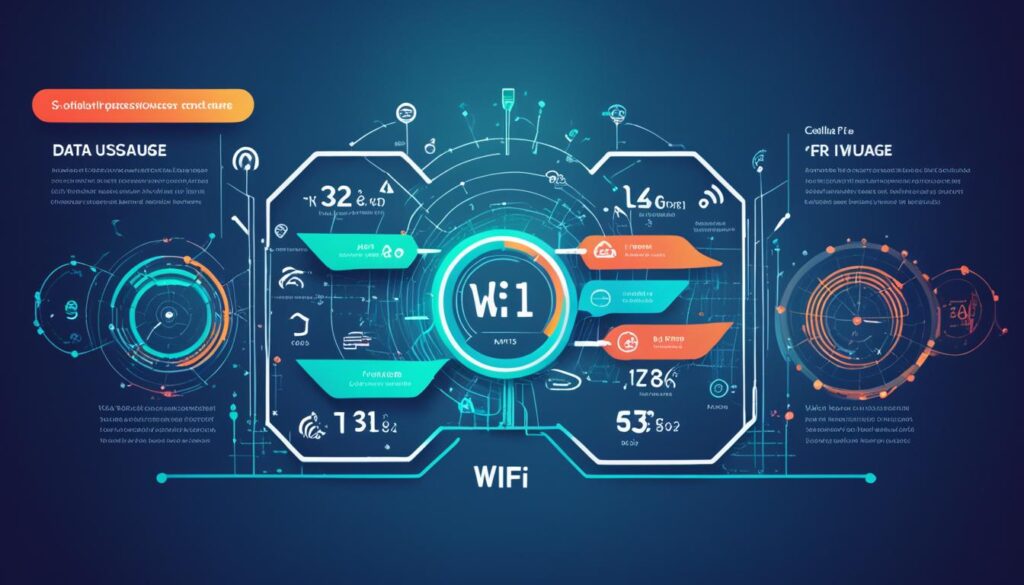
Effective management of data usage is essential for optimizing your smartphone network. It is important to have a clear understanding of how data is consumed on different networks, whether you are connected to a Wi-Fi network or a cellular network.
Managing Data Usage on Wi-Fi and Cellular Networks
When connected to a Wi-Fi network, data usage is typically unlimited or dictated by the data plan offered by your internet service provider. This means you can stream videos, download files, and browse the internet without worrying about data limits.
On the other hand, when using a cellular network, it is crucial to be mindful of your data plan limitations to avoid unexpected overage charges. Most mobile carriers offer different data plans, each with its own cap on monthly data usage.
To efficiently manage data usage on Wi-Fi and cellular networks, consider the following tips:
- Monitor Your Data Usage: Keep track of how much data you are using on a regular basis. Most smartphones have built-in tools that allow you to view your data usage and set notifications when you approach your data limit.
- Reduce Data-Heavy Activities: Avoid excessive streaming, downloading large files, or using data-intensive apps when connected to a cellular network. Instead, utilize Wi-Fi whenever possible for these activities.
- Optimize App Settings: Some apps have options to reduce data usage by adjusting settings such as video quality or automatic updates. Explore these settings to conserve data on both Wi-Fi and cellular networks.
- Utilize Offline Features: Take advantage of offline capabilities offered by certain apps to access content without using data. Downloading music, videos, maps, or documents when connected to Wi-Fi can help minimize data usage later.
By implementing these strategies, you can effectively manage and optimize your data usage, ensuring that you stay within your data plan limitations and avoid unnecessary charges, whether you are connected to a Wi-Fi network or a cellular network.
Reliability of Different Networks
When it comes to network connectivity, reliability is a key factor to consider. The performance of different networks can vary based on various factors such as network coverage, network performance, and the technologies implemented. Currently, most smartphone users rely on 4G networks, which offer a reliable and consistent connection. However, the emergence of 5G networks presents exciting advancements in terms of speed and network performance.
When assessing the reliability of different networks, it’s essential to research network operators and read user reviews to gain insights into their network performance. Network coverage maps provided by the network operators can also help determine if their service meets your needs. Additionally, factors such as network congestion and maintenance can affect network reliability, so it’s important to consider these aspects as well.
Whether you’re considering a 4G or 5G network, it’s crucial to choose a reliable network provider in your area. Popular network providers, such as AT&T, Verizon, T-Mobile, and Sprint, offer a range of plans and services. Comparing the offerings of different network providers can help you make an informed decision. It’s also worth considering the specific network technologies implemented by each provider and their compatibility with your smartphone.
Ultimately, finding the most reliable network is a combination of considering network coverage, performance, user reviews, and the technologies used. By doing thorough research and assessing your specific needs, you can choose a network provider that offers the best network reliability for your smartphone.
Source Links
Understanding Smartphone Pricing Trends 2024
Have you ever wondered why smartphone prices seem to fluctuate so frequently? And what can we expect in terms of pricing trends for the year 2024? In this article, we will delve into the world of smartphone pricing, analyzing the factors that influence pricing movements and examining the projected trends for the future.
Smartphones have become an essential part of our lives, connecting us to the digital world and enhancing our productivity. But with the multitude of options available, it can be challenging to navigate the complex landscape of smartphone pricing. That’s why understanding the trends and factors that shape smartphone prices is crucial for making informed purchasing decisions.
Join us as we explore the current state of smartphone pricing in 2024, uncover the key drivers behind pricing movements, analyze price segmentation in the market, and investigate the impact of emerging technologies and consumer psychology on smartphone prices. We will also take a closer look at the pricing strategies of top manufacturers and examine the role of carrier deals and subsidies in shaping smartphone pricing.
So, what influences smartphone prices? How do different brands and models compare in terms of pricing? And what will the future hold for smartphone affordability? Get ready to dive deep into the world of smartphone pricing trends and discover the insights that will help you make savvy decisions when purchasing your next mobile device.
Key Takeaways:
- Understanding the factors that influence smartphone pricing trends.
- Exploring the current state of smartphone pricing in 2024.
- Analyzing price segmentation and the variations across different brands and models.
- Examining the impact of emerging technologies and consumer psychology on smartphone prices.
- Discovering the pricing strategies of top manufacturers and the role of carrier deals and subsidies.
Market Overview: The State of Smartphone Pricing in 2024
In this section, we will provide a comprehensive overview of the smartphone market in 2024, with a focus on pricing trends. The introduction of 5G technology has had a significant impact on smartphone prices, as manufacturers strive to incorporate this advanced technology into their devices. Consumers’ demand for smartphones has also evolved, influencing pricing strategies to cater to their preferences and needs. To help readers understand the variations in smartphone prices, we will compare prices across different brands and models.
The Impact of 5G on Smartphone Prices
The introduction of 5G technology has revolutionized the smartphone market and impacted pricing trends. As manufacturers incorporate 5G capabilities into their devices, the cost of production increases, leading to higher smartphone prices. However, competition among manufacturers has gradually driven down prices, making 5G smartphones more accessible to a wider range of consumers. The adoption of 5G technology has also fueled innovation, prompting manufacturers to offer competitive pricing to attract customers.
Shifts in Consumer Demand and Pricing Strategies
Consumer demand plays a critical role in shaping smartphone prices. As consumers seek devices with enhanced features and functionality, manufacturers have adjusted their pricing strategies accordingly. For example, the demand for smartphones with larger screens, advanced cameras, and longer battery life has driven prices higher for devices that cater to these preferences. On the other hand, there is also a demand for more affordable smartphones that provide value for money, leading to the introduction of budget-friendly options.
Comparing Smartphone Prices
To gain a better understanding of smartphone pricing trends, it is essential to compare prices across different brands and models. This comparison allows consumers to make informed decisions based on their budget and desired specifications. Several factors influence smartphone prices, including brand reputation, build quality, camera technology, processor capabilities, and storage capacity. By comparing prices, consumers can identify devices that offer the best combination of features and affordability.
| Brand | Model | Price Range |
|---|---|---|
| Apple | iPhone 13 | $699 – $1,399 |
| Samsung | Galaxy S21 | $799 – $1,199 |
| Pixel 6 | $599 – $899 | |
| OnePlus | 9 Pro | $699 – $1,099 |
| Xiaomi | Redmi Note 10 | $199 – $299 |
Key Drivers Behind the Latest Pricing Movements

In today’s smartphone market, pricing movements are influenced by several key drivers. Understanding these factors is essential for both consumers and manufacturers to navigate the dynamic landscape of smartphone pricing. In this section, we will examine the drivers that shape smartphone prices, including production costs, supply and demand dynamics, and technological advancements.
1. Production Costs: The cost of manufacturing smartphones plays a significant role in determining their prices. This includes expenses associated with research and development, raw materials, labor, and marketing. Manufacturers must carefully balance these costs with consumer demand and market competition to set competitive pricing strategies.
2. Supply and Demand Dynamics: The interaction between supply and demand is a crucial driver of smartphone pricing. When supply exceeds demand, prices tend to decrease to stimulate sales and compete in the market. Conversely, limited supply and high demand can lead to price increases. Factors such as production capacity, component availability, and market trends impact the supply and demand dynamics in the smartphone industry.
3. Technological Advancements: Rapid technological advancements have a direct impact on smartphone pricing. The introduction of new features, improved performance, and cutting-edge technologies often result in higher production costs, which manufacturers may pass on to consumers. However, as technology evolves and becomes more accessible, prices tend to decrease over time.
By considering these drivers, manufacturers can strategically price their products to meet market demand and achieve profitability. Additionally, consumers can make informed decisions based on their budget and desired smartphone features. Understanding the factors influencing smartphone prices empowers both parties to navigate the dynamic pricing movements in the smartphone market.
Analysis of Price Segmentation in the Smartphone Market
In this section, we will delve into the fascinating world of price segmentation in the smartphone market. Understanding the different price segments is crucial for consumers who are looking to make an informed purchase decision. We will explore the dynamics of the entry-level market, the evolution of mid-range price points, and the trends at the premium end.
Entry-Level Market Dynamics
The entry-level smartphone market caters to budget-conscious consumers who are seeking affordable devices without compromising on essential features. These smartphones are typically priced below the mid-range and premium options, making them accessible to a wide range of customers.
Brands such as Xiaomi, Motorola, and Nokia have gained popularity in this segment by offering reliable performance, decent cameras, and long battery life at competitive prices. Additionally, the rise of Chinese brands like Realme and Oppo has intensified the competition, resulting in more choices for consumers in the entry-level price range.
With advancements in technology and manufacturing processes, entry-level smartphones now offer impressive displays, capable processors, and improved software experiences. This has led to higher customer satisfaction and increased adoption of entry-level devices as users recognize the value they offer.
Mid-Range Price Point Evolution
Mid-range smartphones strike a balance between affordability and premium features, making them appealing to a broad audience. These devices often offer superior camera capabilities, higher-resolution displays, and faster processors compared to entry-level options.
Brands like Samsung, Xiaomi, and OnePlus have carved out a significant share of the mid-range market by offering flagship-like experiences at more affordable prices. These devices cater to consumers who desire high-performance devices without breaking the bank.
As technology progresses, mid-range smartphones are now capable of supporting 5G connectivity, offering ample storage, and featuring impressive battery life. This has positioned mid-range devices as attractive alternatives to premium smartphones, particularly for users who prioritize value for money.
What’s Happening at the Premium End?
Premium smartphones are known for their cutting-edge features, sophisticated designs, and premium materials. These devices often come with flagship processors, stunning displays, advanced camera systems, and unique software features that cater to power users and tech enthusiasts.
Leading brands such as Apple, Samsung, and Google dominate the premium end of the market, with their devices commanding higher prices due to their exceptional build quality and industry-leading innovations.
The premium segment is constantly evolving, with brands pushing the boundaries of technology. Features like foldable displays, multiple camera lenses, and augmented reality capabilities are becoming more prominent in this segment, captivating consumers who seek the latest and greatest in smartphone technology.
Smartphone Pricing Trends by Region
In this section, we will examine the variations in smartphone prices across different regions and explore the regional smartphone pricing trends. Understanding these trends is essential in gaining insights into the global landscape of smartphone pricing.
When it comes to smartphone pricing, there are several factors that influence regional variations. Market competition, consumer purchasing power, and local demand all play significant roles in shaping smartphone prices in different regions.
Market Competition: The level of competition among smartphone manufacturers within a particular region impacts the pricing of smartphones. In regions with intense competition, manufacturers may lower prices to attract more customers and gain market share.
Consumer Purchasing Power: The purchasing power of consumers in a specific region also affects smartphone prices. In regions with higher average incomes and disposable incomes, smartphone prices tend to be higher, as consumers are willing to pay a premium for the latest and high-end devices. Conversely, in regions with lower purchasing power, smartphone prices may be more affordable to cater to a larger consumer base.
Local Demand: Local demand for smartphones can drive pricing trends in various regions. For example, in regions where there is a higher demand for budget-friendly smartphones, manufacturers may focus on offering affordable devices to cater to this market segment.
To illustrate the variations in smartphone prices by region, take a look at the table below:
| Region | Average Smartphone Price (USD) |
|---|---|
| North America | 800 |
| Europe | 700 |
| Asia-Pacific | 500 |
| Middle East | 600 |
| Africa | 300 |
| Latin America | 400 |
This table provides an overview of average smartphone prices in different regions. It highlights the variations in pricing across regions, with North America and Europe generally having higher average smartphone prices compared to Asia-Pacific, Africa, and Latin America.
By gaining insights into regional smartphone pricing trends, consumers can make informed decisions when purchasing smartphones, considering factors such as their budget, regional market dynamics, and value for money.
Top Manufacturers and Their Pricing Strategies

When it comes to the smartphone market, certain manufacturers stand out for their innovative products and successful pricing strategies. In this section, we will examine the pricing approaches adopted by two industry leaders: Samsung and Apple. By understanding the strategies employed by these top manufacturers, readers can gain insights into how pricing decisions shape the smartphone industry.
Innovations from Samsung and Their Market Implications
Samsung, known for its cutting-edge technology and market-leading devices, employs a pricing strategy that emphasizes the value of its innovations. The company consistently introduces new features and advancements, such as enhanced camera systems, improved displays, and powerful processors. By offering these advancements, Samsung positions itself as a premium brand, justifying its higher price points. Samsung’s pricing strategy focuses on providing a premium experience to its customers, ensuring that they receive the latest and most advanced technology available in the market.
These innovations have significant market implications. Samsung’s commitment to technological advancements and premium features allows the company to cater to a specific segment of consumers who prioritize innovation and are willing to pay a premium for the latest technology. By continuously introducing new features and maintaining high prices, Samsung solidifies its brand reputation and establishes itself as a market leader in terms of innovation and performance.
Apple’s Pricing Framework and Market Reception
Apple, known for its sleek designs and seamless user experience, adopts a pricing framework that positions its products as premium offerings. The company’s pricing strategy is based on a combination of factors, including its brand image, perceived value, and ecosystem integration. Apple products are often considered as status symbols and are associated with quality, craftsmanship, and exclusivity. As a result, Apple can command premium prices for its devices.
“Apple has successfully built a brand that consumers perceive as prestigious and high-end. The company’s pricing reflects the premium experience it offers, appealing to a specific segment of consumers who are willing to invest in the Apple ecosystem.”
Apple’s pricing framework has been met with positive market reception. Despite the higher price tags, Apple consistently generates strong demand and maintains a loyal customer base. The company’s reputation for quality and reliability, coupled with its technological advancements and seamless ecosystem integration, contributes to the perceived value of its products. As a result, Apple’s pricing strategy allows the company to differentiate itself in the market and maintain profitability while delivering exceptional user experiences.
Comparison of Samsung and Apple Smartphone Pricing
| Manufacturer | Pricing Approach | Market Positioning | Key Differentiating Factors |
|---|---|---|---|
| Samsung | Emphasizes value of technological innovations | Premium brand with cutting-edge features | Advanced camera systems, improved displays, powerful processors |
| Apple | Positioned as a premium offering | Exclusive and high-end brand | Sleek designs, seamless user experience, ecosystem integration |
By comparing the pricing approaches and market positioning of Samsung and Apple, it is evident that both manufacturers utilize different strategies to cater to specific consumer segments. While Samsung focuses on showcasing innovation and advanced technology, Apple emphasizes its premium brand image and ecosystem integration. These distinct approaches enable both companies to thrive in the highly competitive smartphone market and attract consumers with varied preferences and priorities.
Emerging Technologies Shaping Future Prices
In the ever-evolving world of smartphones, emerging technologies play a crucial role in shaping future pricing strategies. As advancements continue to revolutionize mobile devices, manufacturers are constantly pushing the boundaries to meet consumer demands and stay ahead in the competitive market.
One of the key areas where we see significant technological advancements is in camera technology. Manufacturers are investing heavily in improving camera capabilities, offering consumers enhanced photography experiences. From high-resolution sensors and advanced image processing algorithms to multiple lenses and optical zoom, these advancements in camera technology drive price variations across smartphone models.
In addition to camera technology, display technology is also evolving rapidly. With smartphone displays becoming larger and more immersive, manufacturers are incorporating technologies like OLED and AMOLED to deliver vibrant colors, sharp contrasts, and improved energy efficiency. These advancements in display technology contribute to the overall cost of smartphones, leading to variations in pricing.
Battery life is another crucial aspect that influences smartphone pricing. As users demand longer battery life, manufacturers are developing technologies such as fast charging and more efficient battery management systems. These advancements, while improving the user experience, also impact the cost of smartphones, leading to pricing variations.
By staying informed about these emerging technologies in smartphones, consumers can better understand how these advancements contribute to future pricing. As manufacturers continue to innovate, it is essential for consumers to consider the trade-offs between features, performance, and price when selecting their next mobile device.
How Operating Systems Influence Smartphone Pricing
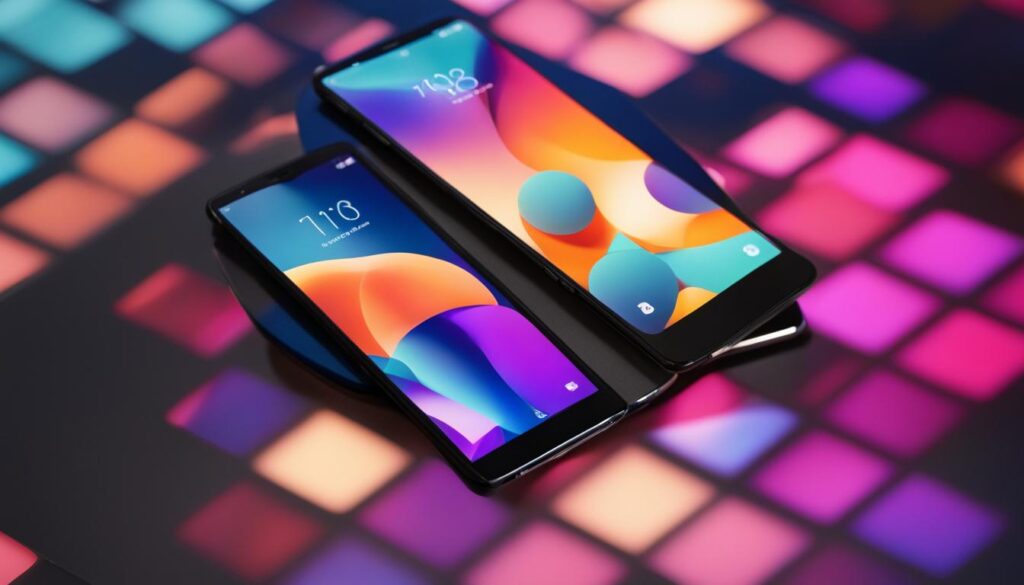
When it comes to smartphone pricing, one factor that significantly influences the cost is the operating system (OS) that powers the device. The two dominant operating systems in the smartphone market are Android and iOS, and each has its own pricing dynamics.
Android vs iOS Pricing
Android, an open-source platform, offers a wide range of devices at varying price points. This flexibility in hardware options allows manufacturers to cater to different market segments, resulting in a broader pricing spectrum. Android smartphones are available in budget-friendly options as well as high-end models with premium features.
On the other hand, iOS, exclusive to Apple’s devices, follows a more standardized pricing strategy. iPhones are generally priced higher compared to Android devices, positioning them as premium smartphones. Apple’s brand reputation, advanced technology, and seamless integration across its ecosystem contribute to the premium pricing.
Impact of Operating Systems on Consumer Preferences and Pricing Strategies
Consumer preferences also play a crucial role in the pricing strategies of Android and iOS devices. While Android’s affordability attracts budget-conscious consumers, iOS devices appeal to those seeking exclusivity, premium design, and seamless user experience.
Moreover, the availability of apps and ecosystem compatibility also influences consumer preferences. Android boasts a larger app library due to its open-source nature, making it a preferred choice for those seeking diverse app options. iOS, known for its stringent app curation and security, appeals to users who prioritize a curated and safe app environment.
In terms of pricing strategies, Android manufacturers have more flexibility to adjust prices based on market demand and competition. The diverse range of Android devices ensures that there are options available for consumers across different price ranges. In contrast, Apple’s pricing strategy for iOS devices focuses on maintaining a premium image and brand value.
The Factors that Drive Pricing Variations
Several factors contribute to the variations in smartphone pricing between Android and iOS devices. One key factor is the cost of hardware components. Apple’s iPhones often incorporate high-end materials, advanced processors, and cutting-edge features, resulting in higher production costs and subsequently higher price tags.
In addition, the exclusivity of iOS and Apple’s ecosystem also influences pricing. The seamless integration between iPhones, iPads, Macs, and other Apple devices creates an ecosystem lock-in effect, which enhances the perceived value and justifies the premium pricing.
Furthermore, the marketing strategies employed by Android manufacturers and Apple also impact pricing. Android manufacturers often adopt aggressive pricing strategies, offering competitive features at lower prices to capture market share. In contrast, Apple’s marketing campaigns focus on brand identity, prestige, and the unique user experience provided by its devices, justifying the higher prices.
In conclusion, the operating system plays a significant role in determining smartphone pricing. Android’s wide range of devices at various price points provides affordability and options, while iOS maintains a premium image with standardized pricing. Consumer preferences, app availability, and marketing strategies also influence pricing variations between Android and iOS devices.
Generative AI and Its Impact on Smartphone Pricing
This section explores the impact of generative AI on smartphone pricing, highlighting the capabilities of AI in mobile devices and how it influences pricing decisions. As smartphones become increasingly powerful and intelligent, generative AI plays a crucial role in enhancing user experiences and driving technological advancements.
Generative AI refers to AI systems that have the ability to generate new content, such as images, music, and text, that closely resemble human-created content. In the context of smartphones, generative AI enables features such as voice assistants, facial recognition, and augmented reality, enhancing the overall functionality and user interaction.
One of the key impacts of generative AI on smartphone pricing is the cost associated with integrating advanced AI capabilities into mobile devices. The development and implementation of cutting-edge AI technologies require substantial investments in research, development, and hardware optimization. These costs are reflected in the pricing of AI-powered smartphones, making them relatively higher compared to devices without such capabilities.
However, the advantages and capabilities offered by generative AI justify the higher price tags associated with AI-powered smartphones. From more accurate voice recognition to personalized recommendations based on user behavior, generative AI enhances the user experience and provides added convenience and efficiency.
Moreover, generative AI has the potential to drive further innovation in smartphone features and functionalities. As AI continues to evolve, its capabilities in mobile devices are expected to expand, leading to advancements in areas such as computational photography, natural language processing, and real-time translation. These advancements can further contribute to the differentiation of smartphone models and influence their pricing.
Overall, generative AI has a significant impact on smartphone pricing by introducing advanced capabilities and features that enhance user experiences. While AI-powered smartphones may come with a higher price tag, the benefits they offer in terms of convenience, efficiency, and innovation make them an attractive option for many consumers.
Smartphone Pricing: Consumer Psychology and Purchase Decisions
In the ever-evolving world of smartphone pricing, consumer psychology plays a significant role in shaping purchase decisions. Understanding the factors that influence consumer behavior can provide valuable insights into the strategies employed by smartphone manufacturers. From perceived value to brand reputation and price sensitivity, various psychological factors contribute to the purchasing choices made by consumers.
One key factor that influences smartphone purchase decisions is the perceived value of a device. Consumers assess the features, specifications, and overall quality of a smartphone to determine its value for the price. A smartphone with advanced features, cutting-edge technology, and superior performance may be perceived as having higher value, leading consumers to be willing to pay a higher price.
Brand reputation is another important consideration for consumers when making smartphone purchasing decisions. Established brands with a strong reputation for quality, reliability, and customer satisfaction often command higher prices. Consumers may be willing to pay a premium for a smartphone from a trusted brand that they believe will deliver a superior user experience.
Price sensitivity is a significant factor influencing smartphone purchase decisions. Consumers have different levels of price sensitivity, with some being more sensitive to price changes than others. Price-sensitive consumers may prioritize affordability and seek out smartphones that offer the best value for their budget, while others may be willing to pay a higher price for a device that meets their specific needs and desires.
“Consumers assess the features, specifications, and overall quality of a smartphone to determine its value for the price.”
The phenomenon of consumer psychology and its impact on smartphone pricing extends beyond individual preferences. Psychological factors can also influence the pricing strategies employed by smartphone manufacturers. By understanding consumer behavior and pricing preferences, manufacturers can develop effective pricing strategies to attract and retain customers.
As the smartphone market continues to evolve and technological advancements drive pricing dynamics, a deep understanding of consumer psychology will be crucial. By keeping abreast of consumer preferences, manufacturers can align their pricing strategies with the factors that drive consumer behavior, positioning themselves competitively in the market.
| Factors Influencing Consumer Purchase Decisions | Impact on Smartphone Pricing |
|---|---|
| Perceived value | Determines the acceptable price range for consumers |
| Brand reputation | Affects consumers’ willingness to pay a premium |
| Price sensitivity | Influences the demand for affordable devices |
“Green” Phones: Eco-Friendly Materials Affecting Costs
In recent years, there has been a growing trend towards eco-friendly smartphones that prioritize sustainability and reduce the environmental impact of phone manufacturing. As consumers become more conscious of their carbon footprint, they are seeking mobile devices that use sustainable materials and practices.
Eco-friendly smartphones are designed to minimize the use of harmful chemicals and non-recyclable materials, making them a more sustainable choice for the planet. These phones often incorporate recycled or biodegradable materials, such as recycled plastic, bamboo, or organic compounds. By using these sustainable materials, manufacturers can reduce the need for extracting new resources and contribute to a circular economy.
“The adoption of eco-friendly materials in phone manufacturing is a positive step towards reducing e-waste and promoting a more sustainable future.” – [Expert Name]
Not only do eco-friendly smartphones help reduce waste and carbon emissions, but they also have an impact on the overall costs of phone manufacturing. While sustainable materials may be slightly more expensive than traditional materials, the long-term benefits outweigh the initial costs. By investing in eco-friendly materials, manufacturers can demonstrate their commitment to sustainability and attract environmentally conscious consumers.
Additionally, the use of sustainable materials can contribute to improved energy efficiency and resource conservation. For example, some eco-friendly smartphones feature energy-saving displays, low-power processors, and recyclable components, resulting in reduced energy consumption and extended device lifespan.
The demand for eco-friendly smartphones continues to grow as consumers prioritize sustainability in their purchasing decisions. Manufacturers are recognizing this consumer sentiment and responding by incorporating sustainable materials and practices in their phone manufacturing processes.
By choosing to purchase eco-friendly smartphones, consumers can contribute to environmental conservation and support the adoption of sustainable practices in the mobile industry.
Smartphone Pricing and the Used Phone Market
In today’s fast-paced world, where technology evolves rapidly, many consumers are opting to buy used smartphones instead of brand new ones. The secondary market for mobile devices offers a cost-effective alternative for those looking to upgrade or replace their phones without breaking the bank. Understanding the dynamics of the used phone market is crucial in making informed decisions and finding the best deals on refurbished devices.
When it comes to pricing used smartphones, several factors come into play. The condition of the device is a significant consideration, as phones in better condition generally command higher prices. A used phone that is in excellent working order, with minimal wear and tear, will have a higher market value compared to one with visible damage or functional issues.
Brand reputation also influences the pricing of used smartphones. Devices from well-known and trusted manufacturers tend to retain their value better than those from lesser-known brands. This is due to factors such as build quality, software support, and customer perception of reliability.
Market demand is another essential aspect affecting the pricing of used phones. If a particular model is in high demand, its price in the secondary market may be significantly higher than other models. Factors such as popular features, limited availability, and discontinued models can drive up the prices of certain used smartphones.
When purchasing a pre-owned mobile device, it is vital to consider the risk-benefit trade-off. While used smartphones generally offer cost savings compared to new ones, there is a potential trade-off in terms of warranty coverage and after-sales support. Buyers should weigh the savings against the potential risks and carefully assess the reliability of the seller.
Refurbished phone prices in the used market can vary widely depending on factors such as device condition, age, model, and market demand. It’s essential to research and compare prices from different sellers to ensure a fair deal. Online marketplaces, specialty used phone stores, and reputable resellers can all be good sources for finding affordable refurbished mobile devices.
By understanding the dynamics of the used phone market and considering factors such as device condition, brand reputation, and market demand, consumers can make informed decisions when purchasing pre-owned smartphones. With proper research and due diligence, it’s possible to find great deals and enjoy the benefits of owning a high-quality device at a fraction of the original price.
The Role of Carrier Deals and Subsidies in 2024 Pricing
In the ever-evolving world of smartphone pricing, carrier deals and subsidies play a significant role in determining the affordability and accessibility of mobile devices. In this section, we will explore how these factors influence smartphone pricing in 2024 and the various options available to consumers.
Analyzing Carrier Pricing Models and Discounts
Mobile carriers often offer exclusive pricing models and discounts to incentivize customers to choose their services and devices. These pricing models can vary, with options such as installment plans, lease agreements, and trade-in programs. By analyzing carrier pricing models and discounts, consumers can determine the most cost-effective way to acquire the latest smartphones.
Subscription Pricing Plans
Another pricing option gaining popularity in 2024 is subscription-based plans offered by mobile carriers. These plans allow customers to pay a monthly fee that covers the cost of the device and includes additional perks such as unlimited data or device upgrades. Subscription pricing plans provide flexibility and convenience for consumers, allowing them to access premium smartphones at a more affordable monthly cost.
The Interplay Between Unlocked Phones and Carrier Deals
Unlocked phones, which are not tied to a specific carrier, have also become a part of the pricing landscape. Consumers can purchase unlocked phones upfront and then choose a carrier and plan that best suits their needs. This option offers flexibility and the ability to switch carriers without being locked into a contract. Additionally, carriers often offer deals and promotions specifically for unlocked phones, making them attractive options for budget-conscious shoppers.
In conclusion, carrier deals and subsidies significantly impact smartphone pricing in 2024. By understanding carrier pricing models and discounts, exploring subscription pricing plans, and considering the interplay between unlocked phones and carrier deals, consumers can make informed decisions and find the best pricing options for their desired mobile devices.
Forecasting Smartphone Pricing Beyond 2024
In this section, we will explore the long-term trends and predictions for smartphone pricing beyond the year 2024. By analyzing the evolving mobile market and considering various factors that may impact pricing, we can gain insights into the future affordability of smartphones.
Long-Term Trends and Predictions
As the technology landscape continues to evolve, the smartphone market is expected to undergo significant changes in the coming years. Advancements in areas such as artificial intelligence, 5G connectivity, and sustainable materials are likely to shape the features and manufacturing costs of future smartphones.
Moreover, as competition in the mobile market intensifies, manufacturers may explore innovative pricing strategies to capture consumer attention. This could include flexible pricing models, such as subscription plans or trade-in offers, that make high-end smartphones more accessible to a wider audience.
Additionally, the increasing demand for eco-friendly devices may lead to the adoption of sustainable materials and manufacturing processes, potentially impacting smartphone pricing. Manufacturers that prioritize sustainability may face additional costs associated with sourcing and implementing environmentally friendly materials, which could influence the overall pricing of their products.
Is Smartphone Affordability on the Horizon?
One of the key questions surrounding future smartphone pricing is whether affordability will improve or remain a challenge for consumers. While advancements in technology often lead to higher production costs initially, economies of scale and competition in the industry can eventually drive prices down.
As more emerging markets embrace smartphone adoption, manufacturers may develop cost-effective models specifically designed to cater to these markets’ needs and budget constraints. This could contribute to increased affordability and accessibility of smartphones in regions where they were previously considered a luxury item.
Furthermore, government initiatives and regulatory policies aimed at promoting digital inclusion and reducing the digital divide may also play a role in shaping smartphone affordability in the long run. Subsidies and incentives provided by governments or mobile carriers could help lower the upfront cost of smartphones, making them more affordable for a broader range of consumers.
Overall, while predicting exact pricing scenarios beyond 2024 is challenging, it is clear that ongoing technological advancements, market competition, and changing consumer demands will continue to impact the affordability of smartphones.
By keeping a pulse on these long-term trends and predictions, consumers can stay informed about the evolving smartphone landscape and make strategic purchasing decisions that align with their needs and budget.
Buying Smartphones from the Store
When it comes to purchasing smartphones, buying from a retail store offers several advantages over online shopping. In-store shopping provides a hands-on experience that allows you to compare prices, receive personalized assistance, and assess the physical condition of the device before making a purchase. These benefits can help you make an informed decision and ensure that you are getting the best value for your money.
One of the key advantages of buying from a store is the ability to compare prices from different retailers. By visiting different stores, you can compare in-store smartphone prices and take advantage of any promotional offers or discounts that may be available. This can help you find the best deal and potentially save money compared to online prices.
Another benefit of buying from a physical store is the opportunity to receive in-person assistance from knowledgeable staff. Store employees can provide expert advice and help you find a smartphone that meets your specific needs and preferences. They can also answer any questions you may have and guide you through the purchasing process, ensuring a smooth and hassle-free experience.
Furthermore, buying from a store allows you to physically inspect the device before making a purchase. You can check the device for any physical damages or defects, ensuring that it is in optimal condition. This provides peace of mind and reduces the risk of receiving a faulty or damaged smartphone.
Overall, purchasing smartphones from retail stores offers numerous advantages, including the ability to compare prices, receive in-person assistance, and assess the physical condition of the device. These benefits contribute to a more satisfying shopping experience and allow you to make an informed decision when buying a new smartphone.
Buying Smartphones Online
When it comes to purchasing smartphones, buying online has become increasingly popular in recent years. Online smartphone purchases offer several advantages that make the process convenient and cost-effective for consumers. One of the main benefits is the convenience of shopping from the comfort of your own home. Instead of visiting multiple stores and dealing with crowds, you can browse through a wide range of options with just a few clicks.
Another advantage is the access to a wider selection of smartphones. Online retailers carry a vast inventory of models and brands, giving you the opportunity to explore different options and find the perfect smartphone that meets your needs and preferences. Additionally, e-commerce platforms often provide detailed product descriptions and customer reviews, allowing you to make an informed decision before making a purchase.
Perhaps one of the most enticing advantages of buying smartphones online is the potential for deals and discounts. Online retailers frequently offer exclusive promotions and sales that you may not find in physical stores. These online deals on smartphones can save you money and help you find the best value for your purchase. It’s essential to keep an eye out for these discounts and compare prices across different online platforms to ensure you’re getting the best possible price.
Source Links
Smartphone Features
Smartphones have become an indispensable part of our lives, revolutionizing the way we communicate, work, and entertain ourselves. These multifunctional devices offer an array of features that cater to our diverse needs and preferences. From capturing stunning photos to providing lightning-fast connectivity, smartphones have come a long way in terms of innovation and functionality.
But with so many options available in the market, it can be overwhelming to choose the right smartphone that meets all your requirements. Which features should you prioritize? What are the essential features that a smartphone should have? Let’s explore the must-have features that make a smartphone stand out from the pack and enhance your user experience.
Key Takeaways:
- Smartphones offer a wide range of features and capabilities that enhance our daily lives.
- When choosing a smartphone, it’s important to consider the specific features that align with your needs and preferences.
- The must-have features of a smartphone include camera and video capabilities, battery life, security features, connectivity options, and voice command capabilities.
- Understanding these key features will help you make an informed decision when purchasing your next smartphone.
Camera and Video Features
The camera is a crucial component of a smartphone, allowing users to capture stunning photos and videos. Smartphone cameras have evolved significantly, providing advanced features and improved performance.
Camera Quality
When selecting a smartphone, camera quality is a significant consideration. Some models offer exceptional image resolution and superior performance, enabling users to capture professional-grade photos. Whether you’re capturing landscapes or important moments, a high-quality camera ensures that every detail is preserved.
Dual Cameras
Dual cameras have become increasingly popular in smartphones. This innovative feature enables users to capture depth, resulting in enhanced image quality and a more immersive photography experience. The combination of two cameras allows for better focusing and enhanced zoom capabilities, providing a versatile tool for any photography enthusiast.
Portrait Mode
Portrait mode is a sought-after feature in modern smartphones. It adds an artistic touch to portraits by creating a beautiful blurred background effect, putting the subject in focus. This feature is particularly useful for capturing professional-looking portraits or adding depth to your photos. Now, anyone can take stunning portraits with just a smartphone.
In addition to these camera features, smartphones also offer various video features to enhance your videography experience. Whether you’re a content creator or simply recording memories, smartphones provide powerful video capabilities.
Smartphone Video Features
Smartphones offer a range of video features to cater to different needs and preferences. Some notable video features include:
- 4K Video Recording: Capture videos in stunning high-definition quality.
- Image Stabilization: Reduce blurriness and shakiness for smoother videos.
- Slow Motion: Create dramatic slow-motion videos for captivating moments.
- Time-Lapse: Record time-lapse videos to capture the passage of time in a condensed form.
- Video Editing: Edit your videos directly on your smartphone, adding effects, trimming, and merging clips.
With these video features, smartphones allow you to unleash your creativity and produce professional-looking videos effortlessly.
| Camera Features | Smartphone Models |
|---|---|
| Dual Camera with Portrait Mode | Apple iPhone 12 Pro, Google Pixel 4a |
| High-Resolution Camera | Samsung Galaxy S21 Ultra, Huawei P40 Pro |
| 4K Video Recording | OnePlus 9 Pro, Sony Xperia 1 III |
| Image Stabilization | Samsung Galaxy Note 20, Xiaomi Mi 11 |
Battery Features
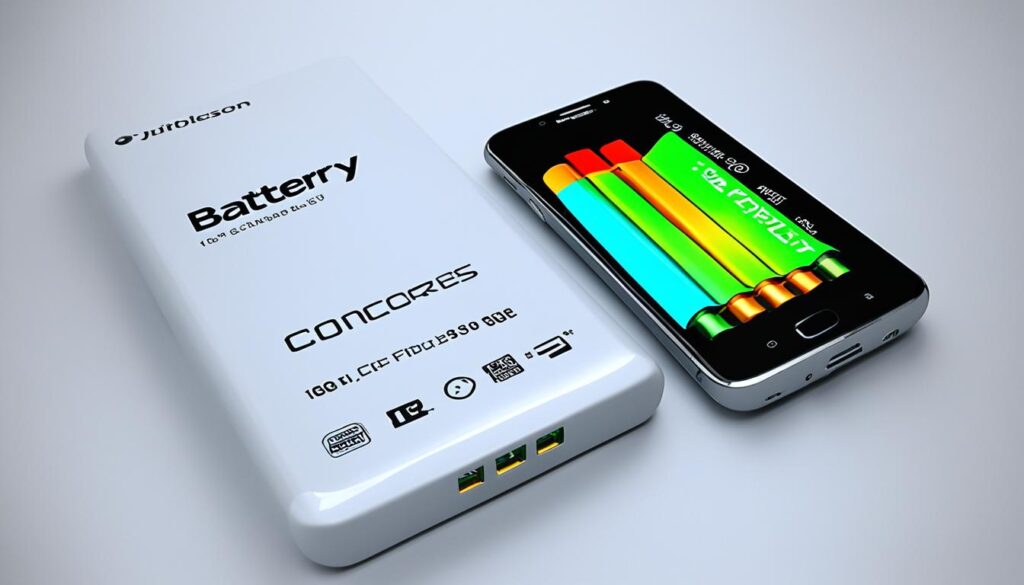
When it comes to choosing a smartphone, one of the key factors to consider is its battery life. After all, what good is a high-performing device if it can’t keep up with your daily usage? Smartphones vary in battery life, with some models offering longer-lasting power than others. It’s important to find a device that can go the distance without needing to be constantly recharged.
Another essential feature that has gained popularity is fast charging. With fast charging technology, you can quickly refuel your smartphone in a short amount of time, allowing you to get back to using it without lengthy waits. No more worrying about running out of battery at the most inconvenient times.
Additionally, wireless charging provides a convenient way to power up your smartphone without the hassle of cables. Simply place your device on a wireless charging pad, and it will start charging automatically. This feature reduces cord clutter and makes charging your phone a breeze.
Battery capacity is another important specification to consider. It indicates how much power your smartphone’s battery can hold. A higher battery capacity means longer usage times before needing to recharge. If you rely heavily on your smartphone throughout the day, opting for a device with a larger battery capacity can ensure it keeps up with your demands.
As smartphone technology continues to advance, improvements in battery features have become a focal point for manufacturers. Longer battery life, fast charging, and wireless charging are all advancements that enhance the user experience and keep us connected for longer periods. When shopping for a new smartphone, be sure to consider the battery features that align with your needs and ensure that your device can keep up with your busy lifestyle.
Security Features
Security features have become increasingly important in smartphones to protect user data and ensure privacy. With the growing dependence on smartphones for various activities, such as online banking, shopping, and social media, it’s crucial to have robust security measures in place to safeguard personal information.
Biometric Authentication
One of the key security features available on modern smartphones is biometric authentication. This technology utilizes unique physical characteristics to verify the user’s identity and grant access to the device. The two primary forms of biometric authentication on smartphones are facial recognition and fingerprint sensors.
Facial recognition technology uses the device’s front camera to capture and analyze the user’s face, allowing for secure and convenient unlocking of the smartphone. By scanning key features and patterns, such as facial contours and unique markers, the device verifies the user’s identity.
Fingerprint sensors, on the other hand, are built into the device’s home button or placed on the rear panel. These sensors capture and analyze the user’s fingerprint, providing an additional layer of security. By comparing the scanned fingerprint with the stored data, the device ensures that only authorized users can access the smartphone.
Secure Authentication Methods
In addition to biometric authentication, smartphones offer various secure authentication methods, such as PINs, passwords, and patterns. These methods provide an alternative to biometric authentication and allow users to choose their preferred security option.
It’s recommended to use strong and unique passcodes when setting up these authentication methods, ensuring higher protection against unauthorized access. Users can also enable additional security features, such as automatic device lock after a specified period of inactivity, to further enhance smartphone privacy.
Protecting User Privacy
Secure smartphones not only focus on authentication but also offer a range of privacy features to protect sensitive data. These features include data encryption, app permissions, and secure browsing. Data encryption ensures that any stored or transmitted information remains unreadable to unauthorized parties, safeguarding user privacy.
App permissions allow users to control the access granted to individual apps, ensuring that sensitive information, such as contacts, location, and photos, is only accessible to trusted applications. Secure browsing features protect users from malicious websites and phishing attempts, enabling safer online experiences.
Connectivity Features
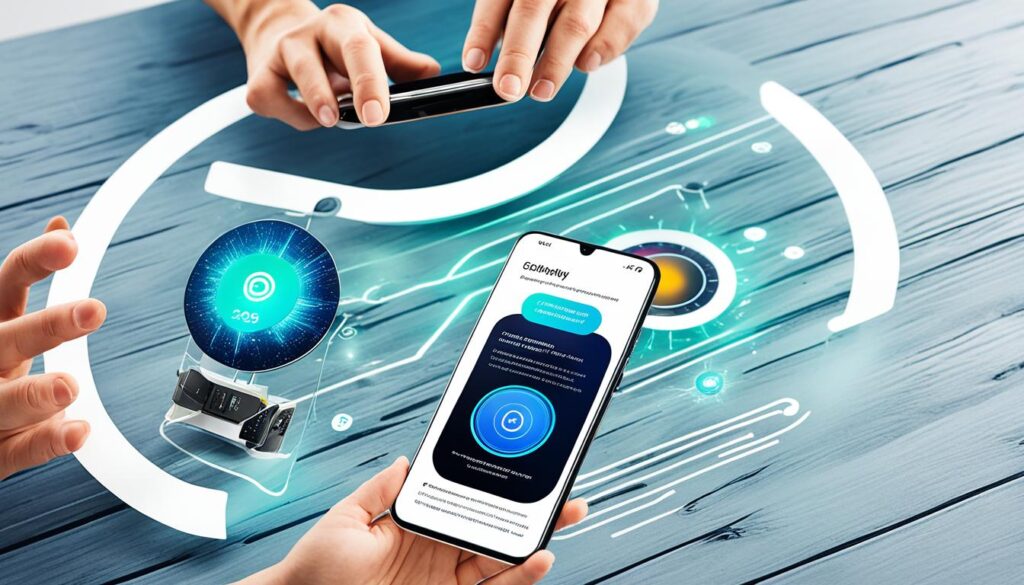
In today’s interconnected world, smartphones have become an essential tool for staying connected to the world around us. With a wide range of connectivity features, smartphones enable seamless communication and easy access to the internet, keeping us connected wherever we go.
5G Technology
One of the most significant advancements in smartphone connectivity is the introduction of 5G technology. With its lightning-fast speeds and improved network capacity, 5G allows users to download and stream content quickly and effortlessly. Whether you’re watching high-definition videos, playing online games, or video conferencing, 5G technology takes smartphone connectivity to a whole new level.
Wi-Fi Connectivity
While cellular data is crucial for on-the-go connectivity, Wi-Fi remains an important feature in smartphones. Wi-Fi connectivity allows smartphones to connect to wireless networks, providing faster and more stable internet access without relying solely on mobile data. Whether you’re at home, in the office, or at a coffee shop, Wi-Fi connectivity ensures you can stay connected and browse the web, stream media, or download files without worrying about data limits.
NFC (Near Field Communication)
NFC is a feature that enables contactless communication between devices. It allows smartphones to interact with other NFC-enabled devices by simply bringing them close together. NFC technology is commonly used for contactless payments, allowing users to make secure transactions with their smartphones. Additionally, NFC can be used for other purposes like seamless pairing with headphones or speakers.
Bluetooth
Bluetooth is another popular connectivity feature found in smartphones. It allows wireless communication between smartphones and other devices, such as headphones, speakers, smartwatches, and even car audio systems. Bluetooth connectivity provides a convenient and hassle-free way to connect and stream audio or share files wirelessly.
With these connectivity features at your fingertips, you can enjoy seamless internet connectivity, fast data speeds, and easy pairing with other devices. Whether it’s browsing the web, streaming media, or connecting with friends and family, smartphones offer a world of possibilities with their advanced wireless connectivity capabilities.
Voice Command Features
Enhancing Smartphone Control through Virtual Assistants, Voice Recognition, and Voice Control
Smartphones have become more than just communication devices; they have evolved into powerful tools that can be controlled with voice commands. These voice command features provide users with a hands-free and convenient way to interact with their smartphones and perform a variety of tasks. By leveraging virtual assistants, voice recognition technology, and voice control, users can navigate their smartphones effortlessly.
Virtual assistants, such as Siri, Google Assistant, and Alexa, are at the forefront of voice command features. Responding to spoken commands, these intelligent assistants can provide information, set reminders, send messages, make calls, and even control smart home devices. With these virtual assistants, users can easily access information and execute tasks without needing to touch their smartphones.
Voice recognition technology plays a crucial role in making voice command features accurate and efficient. Smartphones can accurately recognize and understand spoken commands, allowing users to interact with their devices naturally. This technology ensures that the smartphone responds appropriately and takes the desired action based on the user’s voice input.
Voice control, enabled by these voice command features, empowers users to take full control of their smartphones using only their voice. They can make hands-free calls, send text messages, launch apps, play music, and perform various other functions without the need to touch the device. This feature not only enhances the accessibility of smartphones but also provides a safer and more convenient user experience.
Source Links
Smartphone Design
Smartphones have become an indispensable part of our lives, serving as our communication hub, entertainment center, and productivity tool. But have you ever wondered what goes into the design of these sleek and powerful devices? What makes a smartphone visually appealing, ergonomic, and user-friendly?
In this article, we delve into the world of smartphone design, uncovering the latest trends and innovations that are shaping the future of mobile devices. From aesthetics to materials, form factors to interfaces, we explore the intricate details that make smartphones not just functional gadgets but objects of desire.
So, what exactly are the design choices that manufacturers are making to create smartphones that captivate our senses and enhance our everyday experiences? Let’s uncover the secrets behind the innovative smartphone designs and discover how they are evolving to meet the ever-changing needs and preferences of modern users.
Key Takeaways:
- Smartphone design plays a crucial role in shaping user experience and device success.
- The latest trends in smartphone design include advancements in materials, form factors, and interfaces.
- Design choices impact aesthetics, ergonomics, and overall functionality.
- Understanding smartphone design helps users make informed choices that align with their needs and preferences.
- Stay tuned to uncover the secrets behind the innovative smartphone designs of the future.
Design of the Smartphone Body
The design of the smartphone body encompasses various elements, including the materials used, the form factor, and the ergonomic considerations. In recent years, there have been significant advancements in smartphone materials, with manufacturers opting for sleek and durable options such as glass, metal, and ceramic.
Additionally, the form factors of smartphones have evolved, with the introduction of bezel-less displays, curved screens, and even foldable designs.
These design choices not only impact the aesthetic appeal of the device but also influence its usability and ergonomics, ensuring a comfortable and seamless user experience.
Design of the Smartphone Screen

The design of the smartphone screen is an essential aspect of user interaction and visual experience. Advancements in display technology have led to the emergence of innovative smartphone screens, such as OLED and AMOLED displays, which offer vibrant colors and deep blacks. Additionally, manufacturers have made efforts to maximize the screen-to-body ratio, resulting in larger and more immersive displays. These design choices not only enhance the visual appeal of the smartphone but also provide users with a more engaging and enjoyable viewing experience.
Design of the Smartphone Port
The design of the smartphone port plays a critical role in ensuring connectivity and charging options for users. With the evolution of smartphone technology, manufacturers have made significant advancements to enhance the functionality and convenience of these ports. Two key developments in recent years include the adoption of USB-C ports and the rise of wireless charging.
USB-C: Fast Data Transfer and Versatile Charging
USB-C has become the standard port for many smartphones due to its numerous benefits. This port offers faster data transfer speeds, allowing users to quickly transfer files, photos, and videos between their smartphones and other devices. Additionally, the USB-C port supports versatile charging capabilities, enabling users to charge their smartphones from various power sources, such as power banks and laptops.
The USB-C port’s reversible design eliminates the frustration of plugging in the cable the wrong way, providing a seamless user experience. This design choice has gained popularity among smartphone users who value convenience and efficiency in their daily lives.
Wireless Charging: Convenience and Cable-Free Experience
Wireless charging has revolutionized the way smartphones are powered up. With this technology, users can simply place their smartphones on a wireless charging pad or dock, eliminating the need for cables. The convenience of wireless charging allows users to easily charge their smartphones in various environments, whether it’s at home, in the office, or even in public spaces.
Furthermore, wireless charging offers a clutter-free experience, as there are no tangled cables to deal with. This design choice not only simplifies the charging process but also contributes to a cleaner and more organized workspace.
A Simplified Interaction with the Smartphone
The design of the smartphone port not only enhances the overall functionality of the device but also simplifies the user’s interaction with it. With the USB-C port and wireless charging options, users are less reliant on specific charging cables and can easily connect and charge their smartphones without any hassle.
| Benefits of USB-C Port | Benefits of Wireless Charging |
|---|---|
| Fast data transfer speeds | Convenience and cable-free experience |
| Versatile charging options | Clutter-free charging |
| Reversible design | Ease of charging in various environments |
The design choices for smartphone ports have significantly improved the user experience by providing faster and more convenient connectivity and charging options. Whether it’s utilizing the USB-C port for fast data transfer or embracing wireless charging for a cable-free experience, these design innovations have made smartphones more user-friendly and efficient.
Design of the Smartphone Buttons

Button Placement and Functionality
The design of the smartphone buttons is an essential aspect of user interaction and ease of use. Manufacturers carefully consider the placement and functionality of buttons, ensuring that they are intuitive and easily accessible. The power button, volume rocker, and dedicated buttons for features like camera and voice assistants are all designed to provide a seamless user experience. By focusing on button design, manufacturers aim to enhance user convenience and simplify the operation of the smartphone.
Smartphone Design for Different Purposes
In today’s market, smartphones are no longer just general-purpose devices. Manufacturers are now tailoring smartphone designs for specific use cases, catering to the needs and preferences of different users. By understanding the design considerations for different purposes, users can choose smartphones that best suit their specific requirements.
Smartphone Design for Photography
For photography enthusiasts, smartphone design focuses on camera features and image quality. Manufacturers prioritize high-end camera sensors, multiple lenses, and advanced image processing capabilities. Additionally, smartphones designed for photography often incorporate features like optical image stabilization and dedicated camera modes, allowing users to capture stunning photos and videos effortlessly.
Smartphone Design for Gaming
Gaming smartphones are designed to deliver high-performance gaming experiences. These devices often feature powerful processors, ample RAM, and dedicated cooling mechanisms to ensure smooth gameplay even during resource-intensive tasks. Manufacturers also prioritize large and high-refresh-rate displays, as well as immersive audio technologies, to enhance the gaming experience on smartphones.
Rugged and Waterproof Smartphone Design
In certain industries or outdoor environments, rugged smartphones are the preferred choice. These devices are built to withstand harsh conditions, including drops, extreme temperatures, dust, and water. Rugged smartphone designs incorporate durable materials, reinforced frames, and additional protection against impact and ingress. On the other hand, waterproof smartphones offer an added layer of protection against water damage, making them suitable for users who prioritize durability in wet environments.
With smartphone designs catering to different purposes, users have the flexibility to choose a device that aligns with their specific needs. Whether it is photography, gaming, ruggedness, or waterproof capabilities, smartphone manufacturers are continuously innovating and evolving their designs to provide users with the best experience for their intended use case.
Source Links
Smartphone Maintenance
Did you know that the average smartphone user spends over 3 hours on their device each day?
With smartphones becoming an essential part of our daily lives, it’s crucial to ensure that our devices are well-maintained to prolong their lifespan and maximize their performance.
In this article, we will explore the best practices for smartphone maintenance, including cleaning and protecting your device, eliminating common issues, updating software, installing new apps, and protecting against viruses. By following these tips and tricks, you can keep your smartphone running smoothly, extend its battery life, and avoid unnecessary repairs and replacements.
Key Takeaways:
- Regularly clean and protect your smartphone to keep it in pristine condition
- Troubleshoot and address common smartphone issues to maintain functionality
- Keep your smartphone’s software up to date for improved performance and security
- Optimize app usage and manage storage for optimal smartphone performance
- Implement strong passwords and security measures to protect against viruses and malware
Cleaning and Protecting the Smartphone
Regular cleaning and maintenance are essential for keeping your smartphone in pristine condition. Dust and debris can accumulate in the ports and speakers, affecting performance if not cleaned regularly. To clean your smartphone, follow these steps:
- Use a soft cloth to wipe the screen and body of the phone. Avoid using abrasive materials that could scratch the surface.
- Remove dust and debris from ports using a non-sharp object, such as a toothpick or a soft brush. Be gentle to avoid damaging the ports.
- Clean the camera lens regularly to maintain image quality. Use a microfiber cloth to gently wipe the lens, removing any fingerprints or smudges.
In addition to regular cleaning, it’s important to protect your phone from accidental damage. Here are a few ways to protect your smartphone:
- Use a screen protector to prevent scratches and cracks on the display.
- Invest in a reliable phone case that offers protection against drops and impacts.
- Consider using port covers to prevent dust and debris from entering the charging and headphone ports.
By regularly cleaning and protecting your smartphone, you can ensure its longevity and enjoy optimal performance.
Eliminating Common Smartphone Issues
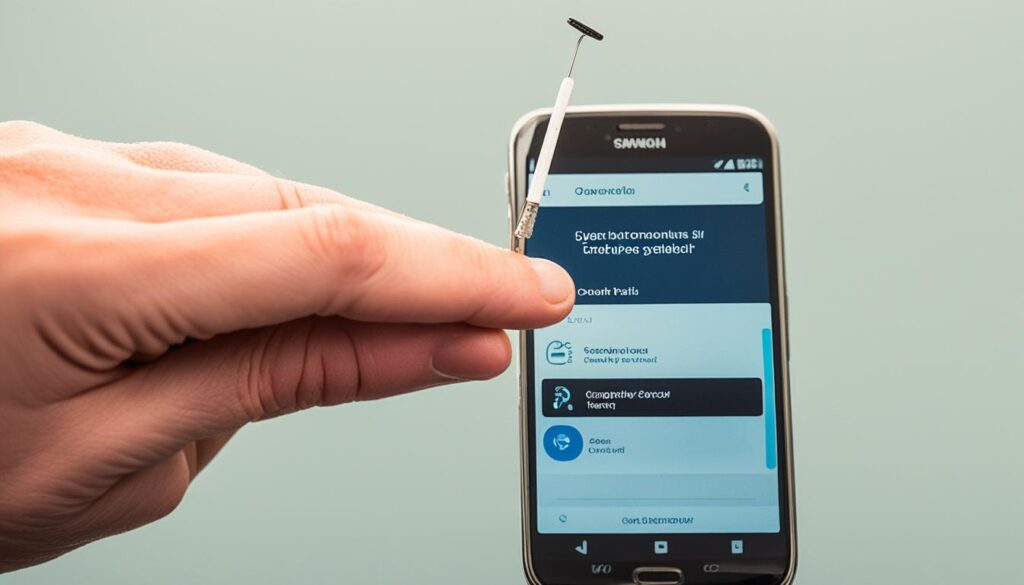
Even with proper maintenance, smartphones can sometimes encounter issues. It’s important to troubleshoot and address these issues to prevent them from affecting the device’s functionality. Common issues include freezing apps, slow performance, and glitchy interfaces.
When your smartphone experiences freezing apps, try closing the app and reopening it. If that doesn’t work, force stop the app by going to Settings > Apps > [App Name] > Force Stop. You can also consider clearing the app cache or uninstalling and reinstalling the app to resolve any potential glitches.
If your smartphone is exhibiting slow performance, there are several steps you can take to improve its speed. First, check for any unnecessary apps running in the background and close them. Clearing the cache and temporary files can also free up storage space and help speed up your device. Additionally, consider disabling any unused widgets or live wallpapers that may be draining your device’s resources.
A glitchy interface can make it frustrating to navigate your smartphone. To address this issue, try restarting your device to clear any temporary files or errors. If the problem persists, you can perform a factory reset, but be aware that this will erase all data on your device, so it’s essential to back up your files beforehand.
By following these troubleshooting steps, you can resolve common smartphone issues and ensure optimal performance. However, if the problems persist or you encounter more complex issues, it’s advisable to seek professional assistance from a trusted smartphone repair service.
Updating Smartphone Software
Keeping your smartphone’s software up to date is crucial for maintaining its functionality and security. Regular software updates provide a range of benefits, including bug fixes, performance enhancements, and security patches that protect against vulnerabilities.
Updating operating systems
Operating system updates are released by smartphone manufacturers to improve system stability, enhance performance, and introduce new features. These updates address known issues and optimize the overall user experience. It is essential to regularly check for and install these updates to ensure that your device is running on the latest version of the operating system.
Managing app updates
App updates are equally important as they often bring new features and improvements to the apps you use on a daily basis. These updates optimize app performance, fix bugs, and ensure compatibility with the latest operating system. Keeping your apps up to date enhances the overall functionality and usability of your smartphone.
By regularly updating your smartphone’s software, you can experience improved performance, enhanced security, and access to the latest features and functionalities. Make it a habit to check for updates and install them promptly to ensure that your device remains up to date and optimized.
Installing New Smartphone Apps
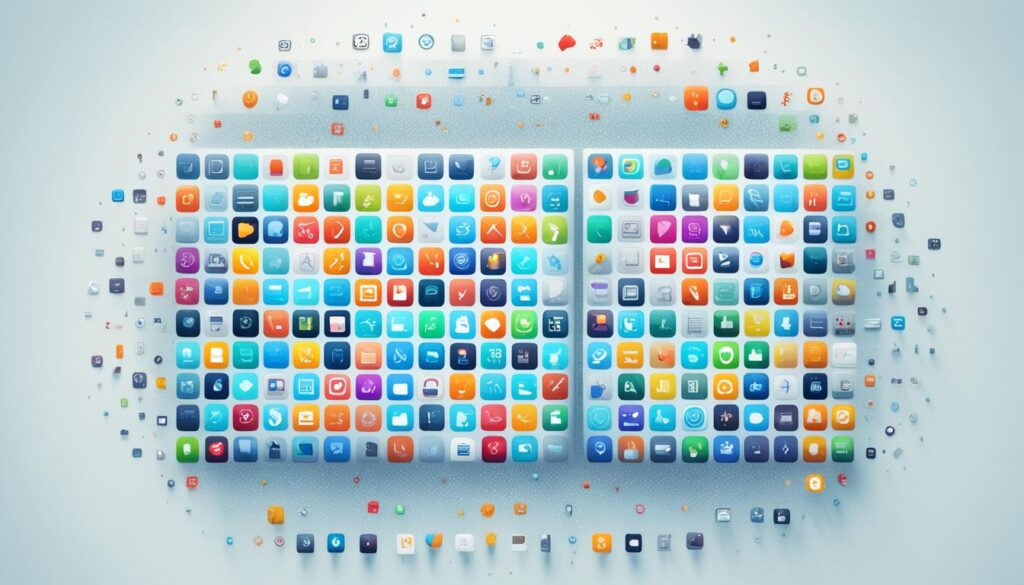
Installing new apps is a great way to add functionality and enhance your smartphone experience. Whether you need a productivity tool, a game to pass the time, or a social media app to stay connected, there’s an app for almost everything. However, it’s important to manage app installation and optimize app usage to keep your smartphone running smoothly and ensure optimal performance.
One key aspect of app management is clearing cache and unnecessary data. Over time, apps accumulate temporary files and data that can take up valuable storage space on your device. Clearing the cache regularly helps free up space and can improve app performance. It’s easy to do this on most smartphones by going to the settings menu and selecting the option to clear app cache.
Another important consideration is storage management. Apps can quickly consume storage space, especially if you have many installed. It’s essential to regularly review your installed apps and remove any that you no longer use or need. This not only frees up storage space but also declutters your smartphone, making it easier to find the apps you do use.
To further optimize app usage and smartphone performance, consider the following tips:
- Disable or uninstall unnecessary apps that come pre-installed on your device.
- Keep your apps updated by regularly checking for available updates in the app store. App updates often include bug fixes and performance improvements.
- Organize your apps into folders to keep your home screen neat and tidy.
- Consider using app optimization tools or cleaners that can help identify and remove unused or unnecessary files.
By managing app installation, clearing cache, and optimizing storage usage, you can ensure that your smartphone performs at its best and avoid issues caused by app overload. Take the time to regularly review and declutter your apps to keep your device running smoothly.
Protecting the Smartphone from Viruses
Using Strong Passwords
In today’s digital age, smartphone security has become crucial. Protecting your device from viruses and malware is essential to safeguarding your personal information. One of the simplest yet most effective ways to enhance smartphone security is by using strong passwords. Avoid common passwords such as “123456” or “password” and opt for a combination of letters, numbers, and special characters. Create unique and complex passwords that are difficult for others to guess. Remember to change your passwords regularly to maintain a high level of security.
Implementing Data Backup
Data backup is another vital aspect of smartphone security. Regularly backing up your important files and data ensures that even if your device gets infected with a virus or experiences a hardware failure, your valuable information will not be lost. Take advantage of built-in backup tools on your device or use cloud storage services like Google Drive or iCloud to securely store your data. Set up automatic backups so that you never have to worry about losing important files ever again.
Avoiding Malware and Phishing Attacks
When it comes to smartphone security, it’s important to be vigilant and cautious while browsing the internet. Avoid clicking on suspicious links or downloading apps from unknown sources, as they may contain malware that can compromise your device’s security. Be cautious of phishing attacks, where attackers impersonate legitimate websites or organizations to trick you into revealing sensitive information. Always verify the authenticity of websites and double-check email addresses before sharing any personal or financial details.
By implementing strong passwords, regularly backing up your data, and staying vigilant against malware and phishing attacks, you can enhance the security of your smartphone and protect your personal information from potential threats. Take the necessary steps to ensure the safety of your device, and enjoy a worry-free mobile experience.
Source Links
Smartphone Bloatware: Trim the Fat from Your Device
Did you know that the average smartphone comes pre-loaded with more than 100 apps? That’s a staggering number considering most users only use a handful of apps regularly. These pre-installed apps, commonly referred to as bloatware, not only take up valuable storage space but can also negatively impact your device’s performance. So, if you want to boost your smartphone’s performance and reclaim storage space, it’s time to trim the fat and remove bloatware.
In this article, we’ll explore the world of smartphone bloatware, understand its origin and impact on your device, and provide strategies for identifying and removing it. We’ll also discuss the legal and privacy concerns associated with bloatware and share tips on how to avoid it when purchasing a new smartphone. So, grab your phone and let’s get started on optimizing your device for a smoother user experience!
Key Takeaways:
- Smartphones come pre-loaded with more than 100 apps on average, leading to a bloated device.
- Bloatware can slow down device performance and consume valuable storage space.
- Removing bloatware can improve your smartphone’s speed and overall user experience.
- Legal and privacy concerns arise from pre-installed apps collecting and sharing user data.
- Strategies such as choosing carrier-independent devices and researching before purchasing can help avoid bloatware.
Understanding Smartphone Bloatware
In order to fully optimize your smartphone’s performance, it is important to understand the concept of smartphone bloatware. Bloatware refers to pre-installed apps or software that come with your device. These apps are often included by manufacturers and carriers and are meant to provide additional functionalities or services to users.
What Is Bloatware?
Bloatware can be defined as any unnecessary or unwanted software that takes up valuable storage space on your smartphone. These apps may include trial versions of applications, unwanted utilities, or carrier-specific applications that cannot be uninstalled easily.
The Origin of Bloatware in Smartphones
The inclusion of bloatware in smartphones has become a common practice among manufacturers and carriers. The origin of bloatware can be traced back to the desire for additional revenue streams and strategic partnerships. Manufacturers often receive financial incentives from app developers to pre-install their applications on smartphones, while carriers establish partnerships to promote their own services or apps.
Common Types of Bloatware
There are various types of bloatware that can be found on smartphones. Some common examples include:
- Trial versions of applications: These are limited versions of apps that are pre-installed on your device. They often come with a limited trial period and may require a subscription or purchase to access the full version.
- Unwanted utilities: These are pre-installed apps that provide functionalities that users may not use or find unnecessary. Examples include weather apps, stock market apps, or third-party app stores.
- Carrier-specific applications: These are apps that are specific to your mobile carrier and may include services such as voicemail, customer support, or custom messaging apps.
Understanding the different types of bloatware on your smartphone is crucial in order to effectively manage and optimize your device’s performance.
The Impact of Bloatware on Your Smartphone’s Performance
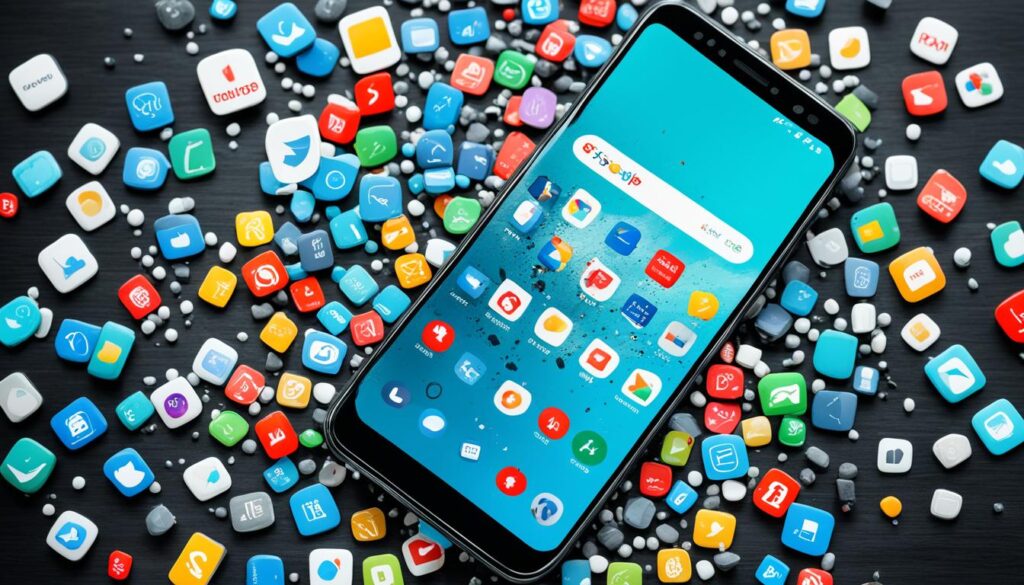
When it comes to smartphone performance, bloatware can have a significant negative impact. This pre-installed software, which often includes unnecessary apps and utilities, can cause your device to slow down, drain battery life, and compromise storage space.
Slower Device Performance
Bloatware takes up valuable system resources, causing your smartphone to run slower than it should. With unnecessary apps running in the background and consuming processing power, tasks that should be quick and seamless can become sluggish and frustrating.
Reduced Battery Life
Unwanted pre-installed apps often run in the background and consume battery power, leading to reduced battery life. This means you’ll find yourself reaching for the charger more frequently and struggling to make your battery last throughout the day.
Compromised Storage Space
Pre-installed apps and utilities that you don’t use still occupy valuable storage space on your device. With limited storage capacity, bloatware can quickly fill up your smartphone, leaving you with less space for important files, photos, and apps that you actually want to use.
To ensure optimal smartphone performance, it’s crucial to remove bloatware and free up resources. By doing so, you can improve device speed, extend battery life, and reclaim valuable storage space for your personal use.
How Manufacturers and Carriers Benefit from Bloatware
Manufacturers and carriers have specific motivations for pre-installing bloatware on smartphones. By including bloatware, they can maximize their revenue and enhance brand visibility through strategic partnerships with app developers.
One of the primary benefits for manufacturers is the opportunity to generate additional revenue. App developers often pay manufacturers to include their apps as pre-installed bloatware on devices. This revenue stream allows manufacturers to offset production costs and increase their profit margins.
Carriers also benefit from bloatware partnerships. By collaborating with app developers, carriers can negotiate valuable sponsorship deals or promotional arrangements. These partnerships enable carriers to supplement their revenue and enhance their offerings to consumers.
Beyond financial gains, manufacturers and carriers capitalize on bloatware to increase brand visibility. Pre-installed apps create a captive audience for their services and foster brand recognition. Users are more likely to interact with or consider purchasing products and services from manufacturers and carriers whose apps are readily accessible on their devices.
Furthermore, bloatware partnerships allow manufacturers and carriers to leverage their position in the market. By featuring apps from popular developers, they align themselves with established brands, cultivating a positive perception among smartphone users.
By including bloatware, manufacturers and carriers can maximize revenue through strategic partnerships with app developers and increase brand visibility.
Industry trends indicate the prevalence of bloatware partnerships. According to recent statistics, manufacturers and carriers continue to forge alliances with app developers to capitalize on the benefits of bloatware. These partnerships contribute to the ongoing trend of pre-installed apps on smartphones, which in turn influences user behavior and consumer preferences.
Consumer Attitudes Towards Pre-installed Apps

In today’s digital landscape, consumer attitudes towards pre-installed apps on smartphones play a crucial role in shaping user preferences and overall user experience. Many users often find themselves frustrated with the presence of unwanted apps and bloatware on their devices, impacting their satisfaction with the product.
Surveys and studies have shown that consumers value the freedom to customize their phones according to their needs and preferences. They prefer a clutter-free user interface that enables them to seamlessly access the apps and features they use most frequently. Pre-installed apps that cannot be removed often hinder this desired experience, leaving users feeling restricted and dissatisfied.
Furthermore, unwanted apps and bloatware can have a negative impact on user experience. They take up valuable storage space, affecting device performance by slowing it down and reducing battery life. Consumers who encounter these issues may develop negative sentiments towards both the apps themselves and the brands associated with them.
Whether it’s redundant utility apps, trial versions of software, or carrier-specific applications, users have made it clear that pre-installed apps that do not align with their needs and preferences can significantly diminish their overall satisfaction with the device.
Manufacturers and carriers are beginning to recognize the importance of addressing consumer concerns regarding pre-installed apps. Some brands have started offering devices with less bloatware or even bloat-free options to cater to the increasing demand for more personalized smartphone experiences.
As consumer attitudes continue to evolve, it becomes crucial for manufacturers and carriers to understand the value of providing users with the freedom to customize their devices, ensuring a seamless and tailored user experience that meets their preferences.
Identifying Bloatware on Your Device
When it comes to optimizing your smartphone’s performance, identifying and removing bloatware is crucial. Bloatware refers to the unused pre-installed apps, unwanted software updates, and non-removable apps that often come preloaded on your device, taking up valuable storage space and potentially affecting performance. In this section, we will discuss some tips and methods to help you identify bloatware on your smartphone.
Pre-installed Apps You Never Use
One way to identify bloatware is by taking a closer look at the pre-installed apps on your device. These apps are often included by manufacturers or carriers, but you may never actually use them. Go through the list of apps on your device and evaluate which ones you rarely or never use. These unused pre-installed apps can be considered bloatware and removing them can free up valuable storage space and improve your device’s performance.
Unwanted Software Updates
Another source of bloatware is unwanted software updates. While staying up-to-date with the latest software is generally recommended for security and performance reasons, some updates may include additional apps or features that you don’t want or need. It’s important to review the details of each software update before installing to determine if any unwanted apps or bloatware are included. Look for options to customize the installation and deselect any unnecessary components.
Non-removable Apps and Services
Non-removable apps and services can also contribute to bloatware on your device. These apps are typically preinstalled by the device manufacturer or carrier and cannot be uninstalled or disabled through regular means. However, there may be alternative methods to disable or hide these apps depending on your device and operating system. Research online forums or consult device-specific guides to learn how to remove or disable non-removable apps and services on your device.
By identifying and removing bloatware from your device, you can reclaim valuable storage space and improve its overall performance. In the next section, we will explore the legal and privacy concerns associated with smartphone bloatware.
Smartphone Bloatware: The Legal and Privacy Concerns

While smartphone bloatware poses performance and user experience challenges, it also raises significant legal and privacy concerns. Pre-installed apps on smartphones may collect and share user data without their consent, compromising their privacy.
Recent privacy scandals and legal cases have shed light on the extent of data collection and sharing by smartphone bloatware. Users should be cautious about granting permissions and be aware of potential breaches in data privacy related to these apps.
To protect user privacy from bloatware, consider the following tips:
- Regularly review and manage app permissions to restrict data access.
- Stay informed about app privacy policies and terms of service to understand how your data is being used.
- Consider using privacy-focused apps or tools that provide enhanced control over data sharing.
- Keep your device’s operating system and apps up to date, as updates often include security patches.
By being proactive in understanding and managing the legal and privacy implications of smartphone bloatware, users can safeguard their data and protect their privacy.
Strategies to Avoid Bloatware on Your Next Purchase
When buying a new smartphone, it’s important to consider strategies that can help you avoid bloatware and ensure a clean user experience. By following these tips, you can select a device that offers a carrier-independent experience, conduct thorough research before making a purchase, and opt for devices that provide a pure Android experience.
Choosing a Carrier-Independent Device
One effective way to avoid bloatware is to choose a carrier-independent device. These devices are not tied to a specific carrier and often come with a minimal amount of pre-installed applications. By opting for a carrier-independent device, you can have more control over the apps and software that are loaded onto your phone, allowing for a clutter-free experience.
Researching and Comparing Models Before Buying
Before making a purchase, it’s crucial to conduct thorough research and compare different smartphone models. Look for brands and models that have a reputation for offering a bloatware-free experience. Read reviews, watch videos, and explore user forums to gather insights from other users who have already purchased the device you’re interested in.
Take note of any complaints or praises regarding bloatware and consider that feedback when making your decision. By investing time in researching and comparing models, you can make an informed choice that aligns with your preferences and helps you avoid bloatware.
Opting for Devices with Pure Android Experience
Another strategy to avoid bloatware is to opt for devices that offer a pure Android experience. Pure Android devices have the advantage of delivering the Android operating system in its unadulterated form, without any manufacturer or carrier modifications.
These devices typically provide a cleaner and faster user interface, devoid of unnecessary pre-installed apps. By choosing a smartphone with a pure Android experience, you can enjoy the benefits of a streamlined device that prioritizes user control and performance.
| Smartphone Brand | Recommended Models |
|---|---|
| Samsung | Galaxy S21, Galaxy Note 20 |
| Pixel 5, Pixel 4a | |
| OnePlus | OnePlus 9, OnePlus 8T |
| Motorola | Moto G Power, Moto G Stylus |
| ASUS | ROG Phone 5, ZenFone 8 |
Consider the recommended smartphone models listed above, which are known for providing a bloatware-free experience.
By following these strategies, you can avoid bloatware and enjoy a clean, efficient, and personalized smartphone experience. Remember to prioritize your preferences and needs when selecting a device, ensuring that it aligns with your desired user experience.
Step-by-Step Guide to Removing Bloatware from Your Phone
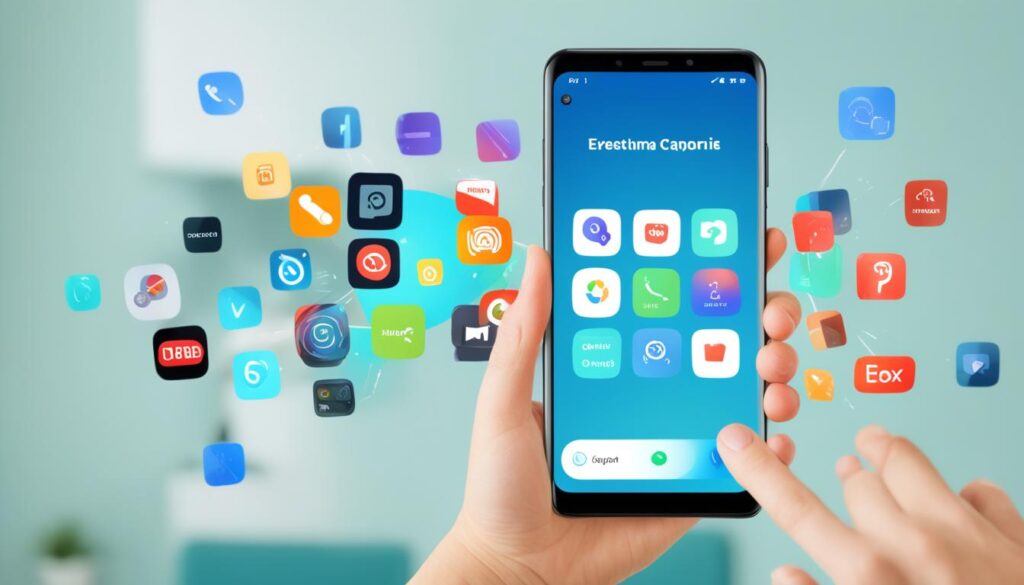
Removing bloatware from your smartphone can significantly improve its performance and free up valuable storage space. In this step-by-step guide, we will explore various methods to remove bloatware from your phone, including using built-in Android options, third-party apps, and rooting your device.
Using Built-in Android Options
Android devices offer built-in options to manage and uninstall pre-installed apps. Follow these steps to remove bloatware using the built-in options:
- Open the Settings app on your Android device.
- Scroll down and select “Apps” or “Applications”.
- Select the app you want to uninstall or disable.
- Tap on the “Uninstall” or “Disable” button.
- Follow the on-screen prompts to complete the uninstallation or disablement process.
By using the built-in Android options, you can remove unwanted pre-installed apps without the need for additional software.
Third-party Apps for Uninstalling Bloatware
If your device doesn’t offer robust built-in options or you prefer a more streamlined approach, you can use third-party apps specifically designed for removing bloatware. Here are a few popular options:
- Package Disabler Pro (Samsung): This app allows Samsung users to disable or uninstall pre-installed apps and bloatware.
- Debloater: Debloater is a versatile app that works on a wide range of Android devices. It enables users to remove unwanted pre-installed apps without root access.
- Root Uninstaller: For rooted Android devices, Root Uninstaller provides advanced features to uninstall system apps and bloatware.
Before using any third-party app, make sure to research and choose a reliable app from a trusted source.
Rooting Your Phone: Risks and Benefits
Rooting your phone gives you full administrative access, allowing you to remove any app or file, including system apps and bloatware. However, it’s important to note that rooting your device comes with both risks and benefits. Some potential risks of rooting include voiding your device warranty, compromising security, and potentially bricking your device if not done correctly.
On the other hand, rooting your phone can offer benefits such as complete control over your device, the ability to install custom ROMs, and increased performance. If you decide to root your device to remove bloatware, it is recommended to thoroughly research the process, follow a reputable rooting guide, and backup your data before proceeding.
Remember, whichever method you choose to remove bloatware from your phone, always exercise caution and backup your important data to ensure a smooth and hassle-free experience.
Managing App Permissions to Minimize Bloatware Risks
In order to minimize the risks associated with bloatware and protect your data privacy, it is crucial to effectively manage the app permissions on your smartphone. By reviewing and adjusting these permissions, you can maintain control over what information each app has access to, reducing the potential for data misuse or security breaches.
Here are some tips on how to manage app permissions on both Android and iOS devices:
- Start by accessing the app settings on your device. On Android, go to the “Settings” app and tap on “Apps” or “Applications.” On iOS, navigate to “Settings” and select “Privacy.”
- From the list of installed apps, choose the app you want to review permissions for.
- On Android, tap on “Permissions” to see the list of permissions the app has requested. On iOS, you will already see a list of permission categories.
- Review each permission and consider whether it is necessary for the app to function properly. For example, if a gaming app requests access to your contacts, it may raise concerns about data privacy.
- Disable any permissions that you deem unnecessary or excessive. Keep in mind that some apps may require certain permissions to function correctly.
- Regularly review and update app permissions as new versions or updates become available. Developers may add or change the permissions that an app requires.
It is important to note that granting excessive permissions to apps can increase the risks associated with bloatware. For example, an app with unnecessary access to your contacts, location, or microphone can potentially collect sensitive information without your knowledge. By managing app permissions effectively, you can minimize these risks and maintain better control over your data.
Maintaining a Bloat-Free Phone Post Cleanup

Once you have removed unwanted bloatware from your phone, it’s important to implement strategies to maintain a bloat-free device. By regularly monitoring installed apps, staying informed about software updates, and creating a streamlined user experience, you can ensure optimal performance and user satisfaction.
Regularly Monitoring and Evaluating Installed Apps
One of the key steps in maintaining a bloat-free phone is to regularly monitor and evaluate the apps installed on your device. Take time to review the apps you have installed and identify any that you rarely or never use. Uninstalling these unused apps will not only free up storage space but also reduce the clutter on your device.
Additionally, pay attention to the permissions requested by each app. If you come across an app that requires excessive permissions or accesses sensitive data without a legitimate reason, consider removing it from your device to ensure your privacy and security.
Staying Informed About Software Updates
Software updates are essential for maintaining the security and performance of your device. Stay informed about the latest software updates released by your device manufacturer and promptly install them. These updates often include bug fixes, security patches, and performance improvements, ensuring a smooth and efficient operation of your phone.
Regularly checking for and installing software updates will not only enhance the overall user experience but also help you stay protected against potential vulnerabilities or security threats.
Creating a Streamlined User Experience
Creating a streamlined user experience involves optimizing your device settings and organizing your app folders to enhance efficiency and ease of use. Consider organizing your app icons into folders based on categories or frequency of use. This will reduce the clutter on your home screen and make it easier to navigate through your apps.
Furthermore, take advantage of features such as app notification settings and adaptive brightness to customize your phone according to your preferences and usage patterns. By tailoring your device settings to suit your needs, you can improve user satisfaction and ensure a smoother, more personalized experience.
By implementing these tips and best practices, you can maintain a bloat-free phone and enjoy a streamlined user experience. Regularly monitoring installed apps, staying informed about software updates, and creating a personalized setup will optimize the performance and usability of your device.
Resources and Tools to Help You Deal with Bloatware
If you’re looking to remove bloatware from your smartphone and optimize its performance, there are several resources and tools available to assist you. These resources can help you identify and remove unwanted apps, manage app permissions, and maintain a bloat-free phone long-term. Here are some noteworthy options:
Bloatware Removal Apps: There are reputable bloatware removal apps that can help you uninstall or disable unwanted pre-installed apps on your device. Some popular options include Norton Clean, CCleaner, and Avast Cleanup. These apps provide a user-friendly interface and comprehensive scanning capabilities to detect and remove bloatware effectively.
App Management Tools: App management tools, such as “SD Maid” and “Astro File Manager,” can help you organize and control the apps on your smartphone. These tools allow you to easily identify and uninstall unused apps, clear app caches, and manage app permissions. They also provide insights into app storage usage, helping you optimize your device’s performance and storage space.
Informative Websites and Forums: Online resources and communities can offer valuable guidance and assistance for dealing with smartphone bloatware. Websites like Android Central, XDA Developers, and Reddit’s r/Android provide forums and guides where users share their experiences and recommend effective solutions. These platforms also offer insights on the latest app reviews, software updates, and trends in the industry.
By utilizing these resources and tools, you can take control of your smartphone’s performance and ensure a bloatware-free experience. Whether you choose to use bloatware removal apps, app management tools, or seek advice from online communities, these resources can support you in optimizing your device and enjoying a more streamlined user experience.









